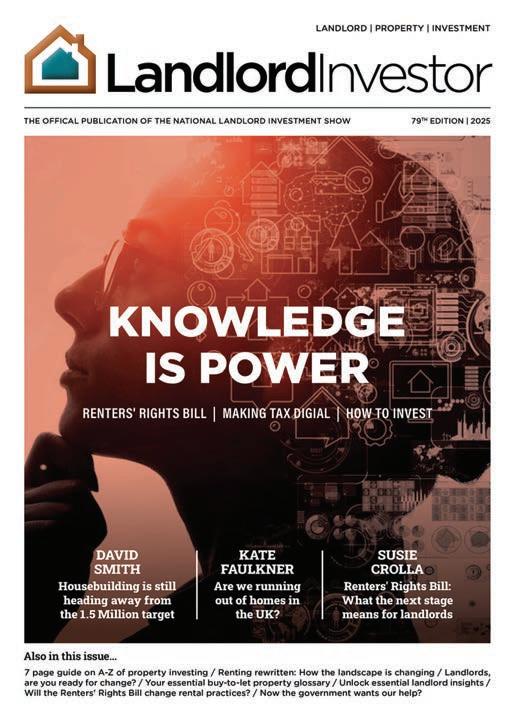








The UK’s Number One Landlord & Property Investment Exhibition has 3 Shows Remaining in 2025. Register now for your FREE show tickets and secure your place while spaces are still available!










The UK’s Number One Landlord & Property Investment Exhibition has 3 Shows Remaining in 2025. Register now for your FREE show tickets and secure your place while spaces are still available!

A very warm welcome to Issue 79 of Landlord Investor Magazine. You might notice we’ve made a few exciting changes to the magazine, and this issue is absolutely packed with valuable content from start to finish. In fact, it’s so full, I’ve only been given a tiny space for my welcome note! You can catch more from me in Show Update, but for now, I just want to say how much I hope you enjoy reading – and offer a huge thank you to all our fantastic contributors. Wishing you every success on your property investment journey. TH
Show Update
Knowledge is Power: Landlords, are you ready for change?
Education
Unlock essential landlord insights with a free LIS membership
Social Impact
Are we running out of homes in the UK?
Social Impact
Housebuilding is still heading away from the 1.5 million target
Social Impact
£39 billion for social housing – But where does that leave the private rented sector?
Social Impact
Q&A: Who is living redefined and how do they assist landlords?
Renters’ Rights
Will the Renters Rights Bill change rental practices?
Renters’ Rights
Renting rewritten: How the landscape is changing
Renters’ Rights
What the Renters’ Rights Bill means for landlords – And why It could be a positive shift
Renters’ Rights
The Renters' Rights Bill: What the next stage means for landlords and why compliance cannot wait
Renters’ Rights
Renters’ Rights Bill 2025: Impact on

Editor
Tracey Hanbury
Design
Marc Riley
Social Media
Charlotte Dye
Printing
IOP Marketing
Renters’ Rights
Can landlords refuse pets? Advice for landlords and tenants
Renters’ Rights
Student Landlords: How could the Renters' Rights Bill affect you?
Investment
Now the Government wants our help?
Investment
Investing in homes that change lives
Investment
Converting the UK rental sector: the new trend replacing buy-to-let
Investment
2025 Guide: How to set up a property investment company in the UK
New Investment Hub
Your essential buy-to-let property
glossary: Key terms for successful property investing
Finance
Alternative deposit schemes: A smart move for landlords
Finance
Baby Boomer landlords face a mortgage crisis: The ticking time bomb of rising rates and ageing assets
Finance
10 Questions with Pauzible
Hot Property Topics
Making Tax Digital for landlords: how to prepare for changes
Hot Property Topics
Bromford wins Aico's Smart Social Spaces competition
| Follow us on...
PLEASE NOTE: The National Landlord Investment Show, LIS Media and Landlord Investor Magazine are content aggregators only. Views, statements and opinions expressed in articles, reviews and other materials herein are those of the authors, exhibitors and third-party contributors and not the editors and publishers of LI Magazine. Under no circumstances does the content of this publication constitute investment or legal advice. We do not undertake to advise individuals or organisations upon investment strategy. All investments should be approached with caution under professional guidance. While every care has been taken in the compilation of this publication and every attempt made to present up-to-date and accurate information, we cannot guarantee that inaccuracies will not occur. LIS Media Limited and our contributors will not be held responsible for any claim, loss, damage or inconvenience caused as a result of any information within these pages or any information accessed through the promoted links. Published by LIS Media, Registered address: Foresters Hall, 25-27 Westow Street, London SE19 3RY. © 2024 LIS Media Ltd.








Kate Faulkner OBE
Leading UK Property Analyst

Paul Shamplina
Landlord Action & Total Property

Jeni Browne
Business Development Director, MFB

Prateek Solapurker
Co-founder, Pauzible

Max Grey
Senior Account Executive, Arthur

Simon Howitt
Senior Partner, Acuity Professional

Oli Reid
Founder, Living Redefined Peter Littlewood Director, iHowz
David Smith
Economics Editor, The Sunday Times
Ellie Bardwell Lettings Director, CJ Hole
Susie Crolla Guild of Letting & Management
Paul Pybus Director, Centurion
Reece Mennie CEO, HJ Collection
Peter Licourinos Director, Project Homes

Staff Editorial Team
In-house Content by LIS Media

TRACEY HANBURY CO-FOUNDER / DIRECTOR
Team: Donegal GAA
Song: Galway Girl, Steve Earle
Film: Dirty Dancing
Food: Indian
Likes: A busy show - can’t beat it
Dislikes: Rudeness
Fave thing about LIS: Building client relationships

KIERAN MCCORMACK SALES DIRECTOR
Team: Manchester United
Song: Bonkers, Dizze Rascal
Film: American Gangster
Food: Indian
Likes: Family time, Man Utd, golf
(not necessarily in that order)
Dislikes: Tinned sweetcorn
Fave thing about LIS: No day is the same (hence the song choice)

CHARLOTTE DYE OPERATIONS DIRECTOR
Team: Spurs
Song: The view from the afternoon, Arctic Monkeys
Film: E.T
Food: Chinese
Likes: Anything four legged and furry
Dislikes: Clowns and Spiders
Fave thing about LIS: Office cuddles with Ollie

NICOLE BONNER CONTENT, EDITOR & PR EXECUTIVE
Team: Crystal Palace
Song: Take It Easy by the Eagles
Film: The Devil Wears Prada
Food: Indian
Likes: Travel, photography & cooking
Dislikes: Tinned tuna & snakes
Fave thing about LIS: The innovative and fast-paced nature of the business.

ALICIA CELA HEAD OF ACCOUNTS
Team: Barcelona FC
Song: Hotel California, The Eagles
Film: Shawshank Redemption
Food: Anything Spanish (I'm very biased lol)
Likes: Cooking great food
Dislikes: Liars. Oh, and liver (can't stand it)
Fave thing about LIS: Socialising with the whole team

STEVE HANBURY CO-FOUNDER / DIRECTOR
Team: Crystal Palace
Song: Plastic Dreams, Jaydee (Original)
Film: Goodfellas
Food: Indian
Likes: Team meetings in the pub
Dislikes: Bad manners
Fave thing about LIS:
Show day (as anything can happen)

MARC RILEY CREATIVE DIRECTOR
Team: Letterkenny Shamrocks
Song: What’s going on? Marvin Gaye
Film: On The Waterfront
Food: Sea
Likes: Clean typography
Dislikes: Last minute edits
Fave thing about LIS: The website

JACOB HANBURY SALES EXECUTIVE
Team: Crystal Palace
Song: Michael Bibi - Got the Fire
Film: Step Brothers
Food: Sunday roast
Likes: Skiing, Gym, Crystal Palace
Dislikes: Dirty finger nails
Fave thing about LIS: Great atmosphere at the shows

LEWIS HANBURY CONTENT CREATOR
Team: Crystal Palace
Song: Fire in Cairo, The Cure
Film: Star Wars, A New Hope
Food: Pasta
Likes: Filming
Dislikes: Editing
Fave thing about LIS: My colleagues

OLLIE HANBURY ENTERTAINMENT & SECURITY MANAGER
Team: Crystal Palace
Song: Who let the dogs out
Film: 101 Dalmatians
Food: Roast Dinners
Likes: Walkies
Dislikes: Poo in bags left on branches
Fave thing about LIS: Getting all the attention

As legislation evolves and tenant expectations shift, it’s never been more important to stay informed. Whether you’re a seasoned landlord or just starting out, navigating the rental landscape can be complex.
Delivered by LRG’s network of trusted London brands, our Renters’ Rights Health Check is designed to help landlords:
Understand upcoming legal changes
Ensure full compliance with current regulations
Protect your property and your income
Get expert, jargon-free advice tailored to you
Book your FREE Renters’ Rights Health Check today.
Visit lrg.co.uk/rentersrights or call 01344 205 799 to speak with our local experts.



Part of


TRACEY HANBURY EDITOR & SHOW FOUNDER
Landlords across the UK are being urged to prepare for a transformation of the Private Rental Sector (PRS), as the government moves forward with significant reforms, including the Renters’ Rights Bill, Making Tax Digital, and a digital transformation of the property market through Proptech.
These sweeping changes, combined with the ongoing housing supply crisis and a need for property investment, make one thing crystal clear: landlords and property professionals need education now more than ever. Stay informed and register for your free ticket here for our Summer Spectacular Show on 9th July in London, Old Billingsgate, for a day of education.
The UK’s PRS provides homes to more than 11 million people, and it’s undergoing a fundamental shift aimed at tightening professionalism across the sector. The era of the so-called "amateur landlord" has long gone, and for good reason. At the National Landlord Investment Show, our mission has always been to ensure that landlords, property investors, and anyone accountable for providing housing have access to the knowledge and expert resources they need to stay compliant and professional. If you're going to be responsible for providing homes, you need to be professional in doing so.
This mission takes us back to the roots of why we founded the National Landlord Investment Show.
Back in 2013, Steve Hanbury and I were young landlords, navigating the challenges of managing our property business. We quickly realised we lacked the knowledge and access to expert services necessary to grow and run our portfolio professionally. It became clear that staying informed and connected to industry professionals was not optional; it was essential for managing and thriving within the UK property sector. And so, the National Landlord Investment Show was born and with it was our growing community of landlords and property professionals who have grown with us over the years.
Applying a theory of change, the first step in adapting is understanding what’s changing. It’s difficult to adjust your property business practices and strategy without first being fully informed. That’s why the theme for our upcoming 9th July Show at Old Billingsgate, London, is focused on providing free, expert-led education to help landlords and property professionals stay up to date and better equipped to respond to change. Register for your free ticket to secure your place today.
In line with the theory of change, once you have access to the right information, you’re in a stronger position to make informed decisions and take appropriate steps to adapt.
This will be our biggest and most dynamic show yet, with one powerful objective: “To provide property professionals with the education, support, and community needed to prepare for the sector's future.”
The National Landlord Investment Show Summer Spectacular is not just another property exhibition; it’s a hub of education and empowerment for landlords and property professionals, offering:
The UK’s PRS provides homes to more than 11 million people, and it’s undergoing a fundamental shift aimed at tightening professionalism across the sector.
• Free access to 50+ seminars led by top property professionals
• 5 expert panel debates tackling the most critical changes affecting the PRS
• A dedicated Landlord & Property Education Hub with exclusive insights and resources to support your journey well beyond the show itself

Stay Informed with our Expert Panels.
We are delving into the biggest changes within the private rented sector through our 5 leading expert panel debates focused on the following core topics:
Brace for Impact: Plan, Prepare & Comply for the Renters’ Rights BillThe UK housing sector is preparing for seismic change. This must-attend panel will examine how the upcoming reforms will impact landlords on the ground.
Hosted by Ian Collins (Journalist, TalkTV) with expert panel speakers: Allison Thompson (National Lettings MD of Leaders Roman Group, LRG), David Smith (Economics Editor of the Sunday Times), Suzanne Smith (The Independent Landlord), Paul Shamplina (Landlord Action/ Total Property), Susie Crolla (Guild of Letting & Management) and Eddie Hughes (Former Housing Minister).

Rent for Good: Supported Letting & Social Impact
With social housing in crisis, this indepth panel will explore how private landlords can be part of the solution through supported letting and longerterm investment strategies.
Hosted by Kate Faulkner OBE (UK Property Analyst) with expert panel speakers: David Smith (Economics Editor of the Sunday Times), Susan Aktemel (Founder, Homes for Good Social Business Group), Ben Rayner (Good Place Lettings), Oli Reid (Founder, Living Redefined), Tracey Hanbury (Co-Founder and Director, National Landlord Investment Show), Eddie Hughes (Former Housing Minister) and Russell Anderson (Commercial Director, Paragon Bank)

Proptech and AI: The Future of Property Investing -
Hosted by Paul Conway (Founder & CEO, Yuno) with expert panel speakers: Vicky Dring (Strategic Digital Consultant), Christian Balshen (Director of Agent Partnerships, Rightmove) and Sam Cope (Founder, August).
Future-Proof Your Finances: Embracing Making Tax Digital
A practical session to help landlords prepare for HMRC’s mandatory digital tax systems – with tools, tips and expert advice.
With expert panel speakers: Manoj Varsani MBE (Founder & CEO, Hammock), Marco Ferrari (Co-Founder & COO, Hammock), Sumit Agarwal (Founder & MD, dns accountants) and HMRC (Speaker TBC).
New Investor Masterclass -
A comprehensive masterclass for firsttime landlords or those looking to start their portfolio in 2025.
Hosted by Jacob Hanbury with expert panel speakers: Josh Turner (LRG), Heather Smail (Heather Smail Property Group Ltd), Simon Zutshi (pin), and Kane Andrews (Rockstar Property Partners) and Sagheer Malik (Group Chief Commercial Officer and MD Retail Finance, Offa) .
Stay Connected with Expert Service Providers.
Staying informed means staying connected. At the National Landlord Investment Show, we bring together 100+ expert property service providers who are at the forefront of industry changes based on their expertise. These professionals offer guidance across every aspect of running a property business, from preparing for Making Tax Digital, to selecting the right property management and letting agents in line with the Renters’ Rights Bill, or for strategies to plan your investment as a new investor.
Whether you’re looking for partners to support with legal matters, mortgage
and financing, tenant/ property management, or wanting to get involved with socially responsible initiatives like ‘rent for good’ in social housing or supported accomodation, you’ll have the opportunity to meet with a wide range of specialists to support with every aspect of running your property business.
Stay Educated through our Landlord & Property Education Community Hub.
As we approach our 93rd live show, we’re proud of the community of property professionals we've built, one that continues to grow and evolve with the sector. Recognising the pace of change and the impact of the digital era, we’ve launched a new membership hub to support landlords and property professionals on demand. The membership community offer a comprehensive platform with exclusive content to navigate the evolving landlord landscape in the form of UK property news, expert market analysis reports, housing policy updates and events designed for your success as a landlord and property investor. So, stay connected beyond our live inperson shows and register to become a member of our free LIS membership community.
Stay Ahead.
To stay ahead of upcoming changes, register for your free ticket to the National Landlord Investment Show on 9th July at Old Billingsgate, London. This year’s Summer Spectacular will be our biggest and most dynamic event to date, and an essential opportunity for any landlord or property investor preparing for the transformative changes within the Private Rented Sector (PRS).
In a time of transformation, education and knowledge aren’t optional; they’re essential. As the saying goes: knowledge is power.
As always, we wish you the very best on your property investor journey.
TH


2025 continues to be a busy year for the National Landlord Investment Show. Just as the first half, the year has been jam-packed, the momentum isn’t stopping. Towards the second half of the year, we're landing in multiple other locations across the UK in 2025, including London, Bristol and Manchester. Attendee registration is open for all 2025 show dates.
Are you a property service provider and wanting to connect with 1000’s of UK landlords, investors and property professionals? Contact the team today to find out more about how to be involved in our live shows or LIS brands, including UK Property News, Property Notify,


TRACEY HANBURY EDITOR & SHOW FOUNDER
Register to join our LIS Membership Community today – a FREE and EXCLUSIVE community membership hub designed for landlords, investors, and property professionals looking to stay informed and ahead of an evolving property market landscape.
The LIS Membership Community offers exclusive access to UK property expert insights and analysis, industry news, education, training and events, ensuring that members can stay informed, empowered, and ahead in the UK Private Rental Sector (PRS) and be part of a community navigating change.
Empowering UK Landlords, Investors and Property Professionals
Established in 2013, the National Landlord Investment Show has been a trusted platform for landlords, investors and property professionals to connect, network and learn. The launch of the LIS Membership Community is a natural evolution of this mission, offering a comprehensive digital hub to support members in navigating the complexities of the UK Property Market beyond the live exhibitions.
Key Benefits of the LIS Membership Community:
• Access to the Members’ ONLY portal – Exclusive access to market reports, expert advice, investment trends and strategies.
• U K Property News – Stay updated on the latest property industry developments, policy & legal changes, and investment opportunities.
• Expert Market Analysis reports by Kate Faulkner OBE, leading UK Property Analyst.
• Renters’ Rights Hub wth exclusive expert reports by Suzanne Smith, The Independent Landlord‘lawyer turned landlord’. other leading industry experts.
• Online & In-Person Events – Gain access to live exhibitions across the UK and exclusive networking Landlord Investor Club (LIC) events.
• Training & Education – Enhance your expertise with expert masterclasses, workshops, and tailored learning content.
Join the LIS Membership Community Today!
There is no fee to join the LIS Membership Community. It is open to all property professionals looking
to stay informed and ahead of the evolving UK Property Market.
Register here to become a member today to access exclusive content, expert insights, and network as part of the LIS Membership community.
Established in 2013, the National Landlord Investment Show has been a trusted platform for landlords, investors and property professionals to connect, network and learn.


KATE FAULKNER OBE
LEADING UK PROPERTY ANALYST
This might seem a bit of a dramatic title, but for the first time, I am really worried. With councils under unprecedented financial strain, homelessness figures rising, and intense competition across both the rental and homeownership sectors, the evidence points to a horrendous housing crisis that can no longer be ignored
According to housing charity Shelter, as of last Christmas, an estimated 354,000 people in England were experiencing homelessness, including over 161,000 children. This represents a 14% year-onyear increase. The breakdown reveals an escalating emergency:
• 326,000 people in temporary accommodation (a 17% annual rise), most of whom are families with children
• 3 ,900 rough sleepers on any given night (up 27%)
• 1 6,600 single people in hostels or homeless accommodation
Moreover, over 1.3 million households remain stuck on social housing waiting lists due to the chronic shortage of genuinely affordable homes for rent.
The Local Authority Dilemma: Councils Running on Empty
With local councils’ budgets stretched to the brink, the usual fallback that is placing homeless families in hotels or B&Bs is becoming increasingly unsustainable. Add to this the government’s statutory obligation to provide housing for asylum seekers, and the system is under severe pressure:
• A s of December 2023, the UK was supporting over 106,500 asylum seekers, including 45,800 in hotel accommodation.
• This figure had only recently dropped from a peak of 56,000 in September 2023, highlighting the scale of the burden on available housing stock.
The Private Rented Sector often the only viable alternative for many is also under immense stress. Despite the UK population growing by over 3 million since 2015, the number of privately rented homes has remained stagnant at around 4.5 million.
With the pressures of trying to house those on social housing waiting lists, there has been additional pressure to house migrant workers coming to the UK, who typically rent in the PRS before settling down and buying a home. And as the following chart shows the PRS was under considerable pressure during 23 and 24, hence rents rising, supported by growth in wages.
Currently it’s estimated by Zoopla that “12 renters are currently chasing each
home for rent. This is down 42% on 2022-24 levels but still higher than prepandemic levels”. Source: https://www. zoopla.co.uk/discover/property-news/ rental-market-report/
And worse still, this level of competition isn’t just at the ‘affordable’ end of the market. I am getting reports that tenants with budgets of £2000+ a month are struggling to find a property to rent, especially if they have children and need to be near to schools and family or other supporting services.
So we now have a housing crisis in the rental sector too, although it’s important to be aware that doesn’t exist everywhere across the UK, some more rural areas especially don’t have the same level of competition and it can take a month or more to let a property.

Source: https://migrationobservatory.ox.ac.uk/resources/briefings/long-term-internationalmigration-flows-to-and-from-the-uk/
What about the buying and selling market?
As with the rental market, this can vary by area, but there are definitely many areas where we have issues, especially from an affordability perspective.
Work by Richard Donnell at Zoopla shows the areas where first time buyers “could afford to buy a third of homes for sale on Zoopla – with a 20% deposit. The following map shows the percentage of all homes for sale where the mortgage repayments per month would be below the average level of rents in the same area”.
As this map shows, it’s pretty difficult for first time buyers to purchase a property too, although on the other end of the scale, with over 50% of those that own a home, owning outright, in the home ownership market, apart from areas like London, Bristol and other areas in the South and East, there is less of a strain on supply and demand than in the social and PRS tenures.
What do you think? What’s happening in your area?
So for me, I think we are heading to a serious crisis of homes available, and indeed in some areas we are already in it, and with the Renters’ Rights Bill coming in, that could make things a lot worse too if landlords continue to sell off their investments.

Source: https://www.linkedin.com/posts/richard-donnell_ftb-housing-mortgages-activity7209453976927227904-slxi
















DAVID SMITH ECONOMICS EDITOR, THE SUNDAY TIMES
1.5 MILLION TARGET
Later this month, on June 20, the government will release official data for housebuilding over the latest 12 months, the 2024-25 fiscal year. They will provide an important staging post in relation to the official target of delivering an extra 1.5 million new homes this Parliament.
There are two important things to bear in mind about that target. The first is that it applies to England only, not the whole of the UK. The second is that it is defined in terms of net housing additions, not traditional housing completions.
What this means is that as well as new housing as usually defined, the target incorporates conversions, such as when larger houses are converted into smaller units, such as flats, something that has happened for as long as anybody can remember.
It also includes conversions from retail, office or other commercial use into residential. The decline of the high street and the increase in workingfrom-home appeared to suggest that this would be quite a rich vein of new housing supply, though the numbers remain relatively low.
We will get the big picture, as I say, on June 20, but the government has already attempted to produce some estimates. Using data from energy performance statistics, which is available weekly, together with building control and other data, officials estimate that net housing additions in 2024-25 (up to March 23) were 199,100. They may go up a bit when the final few days of the fiscal year are added in, but it looks as if we are looking at a figure of about 200,000.
Net housing additions in the period since Labour was elected in July last year, up to March 23 this year, are estimated to have been 142,800.
But, staying with that figure of roughly 200,000 for 2024-25, what does it tell us? It tells us, for a start, that net additional dwellings are still falling.
Net housing additions in the period since Labour was elected in July last year, up to March 23 this year, are estimated to have been 142,800.
The 2024-25 estimate compares a 2023-24 figure of 221,070 net additional dwellings, so implying a fall of nearly 10 per cent. Nor was 2023-24 a vintage year. Net additions then were 6 per cent lower than in the previous year, 2022-23, when the housing market was pulled up sharp by the Liz Truss-Kwasi Kwarteng “mini” budget in September 2022.
The other thing to note about the 200,000 figure is that it is well short of the 300,000 a year average that the government needs to meet its target of 1.5 million new homes during this Parliament. It is, as you will have noticed, just two-thirds of that target. At the current rate, and on the current trajectory, it looks as if the government will be lucky to get to a million.
That things were likely to get worse before they got better was perhaps inevitable. The response of the housebuilders to the crisis of autumn 2022 was to rein back sharply, delaying work on new sites and pausing it on part-completed ones.
That hangover is now lifting, but it is doing so only slowly. The end of the stamp duty reduction in April, the one
welcome legacy of that September 2022 mini budget, has added to the mood of caution.
Most housebuilders are setting increased targets for the coming year, but they are adopting a cautious approach. They welcome the government’s promise of planning reform but want to see action rather than the words that we have mainly had so far.
There are also issues about whether the industry has the workforce to ramp up the supply of new homes to the point where they are consistent with the government’s 1.5 million target. Tighter visa restrictions on foreign building workers, as part of the prime minister’s migration clampdown, will make that even harder.
So, it looks as if so far at least, the supply of new homes has been heading in the wrong direction. There may be a small increase in net housing additions this year, 2025-26, but it is unlikely that this will transform the situation. Only an optimist would think that the government will get close to its 1.5 million target. The question is how big a miss it will be.

PETER LITTLEWOOD DIRECTOR, IHOWZ

£39 BILLION FOR
SOCIAL HOUSING – BUT WHERE DOES THAT LEAVE THE PRIVATE RENTED SECTOR?
The Labour Government has unveiled a £39 billion commitment to build and upgrade social and affordable housing over the next decade, marking one of the most significant state interventions in the housing market since the post-war era.
Described by ministers as a “once-in-a-generation opportunity”, the announcement aims to deliver up to 1.5 million new homes through councils, housing associations, and registered providers (RPs). But while the ambition is grand, the rollout is already exposing mounting tension between the social housing agenda and the increasingly beleaguered private rented sector (PRS).
With new renters entering the market, rising demand, and further legislation on the horizon, landlords are asking: Are we part of the long-term plan – or being priced and regulated out of it?
Hotel Closures Shift Pressure to PRS
One of the most headline-grabbing measures is the planned closure of all asylum-seeker hotels. Individuals granted the right to remain will now be expected to find housing via the PRS.
This policy shift adds thousands more households to an already underpressure rental system. However, PRS supply is moving in the opposite direction: landlord numbers are falling, rents are rising, and regulatory burdens are intensifying.
Crucially, this policy assumes that PRS landlords will absorb these new tenants, without offering meaningful incentives, guarantees, or additional support. With costs rising – from capital upgrades to EPC compliance – this expectation may be dangerously optimistic.
Vagrancy Law Repealed: What Now?
As part of broader housing reforms, the Government is also repealing the 200-year-old Vagrancy Act,
decriminalising rough sleeping. While widely welcomed by campaigners, this move implies a larger responsibility for local councils and landlords to accommodate vulnerable people.
But the question remains: where will they go? Emergency housing stock is limited, councils are stretched, and parts of the PRS are already under strain.
Social Housing Boost Faces Practical Barriers
Despite the record-breaking investment, delivery in the social housing sector faces serious challenges:
• Repairs backlogs and maintenance failures in housing association stock remain widespread
• Awaab’s Law, due possibly in October 2025, will introduce strict new timeframes for tackling damp and mould
• Local Housing Allowance (LHA) remains frozen, reducing affordability for low-income renters
• S everal registered providers (RPs) have collapsed in recent years –including Home REIT and Social Housing REIT – exposing financial instability in the sector
• C ouncil tax rises are increasingly likely, as local authorities seek to fill funding gaps
Even with new capital commitments, some housing experts warn the sector lacks the delivery capacity and resilience needed to scale at speed. Investor confidence in the RP model has also taken a hit, following high-profile failures and governance concerns.
Regional
Amid the challenges, opportunities remain – particularly around infrastructure-led regional growth. Strategic landlords are already tracking developments that may boost rental demand, including:
• Oxford–Cambridge Arc: long-term housing and transport corridor
Even with new capital commitments, some housing experts warn the sector lacks the delivery capacity and resilience needed to scale at speed.
• Lower Thames Crossing: a key link between Essex and Kent
• Sizewell C Nuclear Power Station: major construction workforce demand in Suffolk
• H ospital and school upgrades: part of the Government’s public services overhaul
These projects are expected to generate employment-driven demand for rental accommodation, particularly in regions traditionally underserved by institutional landlords.
The Government appears to be leaning heavily on the PRS to support its wider housing goals – including absorbing new migrants, key workers, low-income households, and those priced out of ownership. Yet landlords report a widening gap between the expectations placed upon them and the support they receive.
While social housing and first-time buyers receive direct state funding, PRS landlords must navigate increasing regulation, higher interest rates, and
reduced tax relief – all while shouldering the risks of complex tenancies.
The upcoming Renters’ Rights Bill –with its abolition of Section 21 and enhanced tenant protections – may improve standards in theory, but many landlords see it as another blow to their autonomy, especially in cases involving antisocial behaviour or unpaid rent.
Landlords across the UK continue to voice frustration that, despite providing housing for over 20% of UK households, they receive little formal recognition in national housing strategy.
For a balanced housing market, policymakers will need to include PRS landlords in the long-term plan. Potential interventions could include:
• C apital gains rollover relief for reinvestment into rental property
• Grants or tax offsets to help meet EPC and Decent Homes requirements
• Fast-track tribunals for possession disputes under the new Section 8 regime
• Digital tools for simplified licensing, compliance, and landlord registration
• Dialogue with industry bodies to improve regulation design and enforceability
Without these kinds of reforms, further attrition from the PRS seems inevitable – just as demand peaks.
The £39 billion social housing programme is a bold, necessary investment in the UK’s long-neglected affordable housing infrastructure. But without a parallel commitment to the viability of the private rented sector, it risks deepening existing imbalances.
Landlords and letting agents remain a critical part of the UK’s housing landscape. Ignoring their challenges now could severely limit the success of broader housing policy goals.
The solution is not binary. Both social housing and the PRS must be supported, modernised, and sustained. One cannot flourish while the other withers.








TRACEY HANBURY EDITOR & SHOW FOUNDER


OLI
REID FOUNDER, LIVING REDEFINED
Our director, Tracey Hanbury of the National Landlord Investment Show, had the pleasure of interviewing Oli Reid, Founder of Living Redefined, for a Q&A session. During the conversation, they explored the origins of Living Redefined, its core mission and purpose, and the innovative ways the organisation works alongside landlords and communities to address and prevent homelessness.
Who is Living Redefined, and how do we assist landlords?
Living Redefined is all about connecting landlords to Social Housing Providers. Think of us like mortgage brokers, but instead of lending, it’s leases. We noticed a gap some years ago, we found that Providers were quite uncommercial, lacked the skills to attract and negotiate with landlords, and equally, landlords found it difficult to find providers.
Living Redefined handles the entire process for both parties from onboarding and negotiation to compliance and posthandover support. We make the entire process simple and structured.
What is Social & Supported Housing, and why is it the way to go?
It’s all about providing accommodation to those who can’t procure it or maintain it on their own. Instead of renting directly to a tenant, you rent to a Charity or a Council, which in turn rents it to occupiers who likely need support.
For landlords, it’s a practical alternative to the increasingly regulated private rental market. With social housing, you get longer leases, reliable rent (often backed by public funding), and fewer voids - all without the hassle of managing tenants yourself.
Why is there a growing demand for supported housing?
I think it’s two-fold, firstly there’s a super high demand for Social & Supported Housing right now, Prisons are full, 6.3 million people on NHS Waiting Lists, 38k Asylum Seekers in Hotels, etc – it’s sort of the perfect storm.
The supply side, you’ve got increasing and largely overbearing regulation in the Renters' Rights Bill, really causing havoc with landlords. So I think you’ve got landlords seeing and hearing more about demand, but are equally running away from the Private Rented Sector (PRS), as it’s just not attractive anymore. So, as an alternative to selling, understandably, landlords are looking at different rental models.
What’s the biggest misconception landlords have about social housing?
Most landlords think social housing is risky - that tenants won’t look after the property or the rent won’t be paid. This is the big difference in the PRS, your occupier is your tenant. In the Social space, your tenant, who pays the rent, is entirely different to the occupier. Don’t get stuck on the occupier; focus on the tenant.
The problem isn’t the model - it’s a lack of education. Sometimes landlords can pre-judge the arrangement before getting into the details.
What services does Living Redefined offer?
We help landlords source suitable properties, match them with vetted housing providers, support lease negotiations, and ensure compliance with safety and regulatory standards. We also offer ongoing education, investment guidance, and access to our online landlord community, where landlords can learn from others and get expert support.
Why do you do this?
Homelessness is something personal to me, not because I’ve been there, but I find it fascinating that it’s 2025, and, at the last count, nearly 5000 people were found rough sleeping in England alone.
I’m a big believer in the market; the market can solve this problem if it wants, and that’s the reason I do it. I believe that with a correctly structured and regulated market, we can end homelessness.
We help landlords source suitable properties, match them with vetted housing providers, support lease negotiations, and ensure compliance with safety and regulatory standards.
How does working with a supported housing provider benefit landlords?
As a landlord, in this arrangement, you’ll likely get long-term leases (3, 5 or sometimes 10-year leases), guaranteed rent and no need to manage tenants or deal with voids. The provider handles day-to-day operations, and the rent is often backed by public funds. It’s a hands-off, stable income model that also happens to have a huge social impact.
How do I assess a supported housing provider?
Look at their track record, funding sources, and who refers tenants to them - councils, the NHS, or the Ministry of Justice, for example. Make sure they
provide proper support services and have policies in place for safeguarding, fire safety, and property upkeep. Every provider that we work with at Living Redefined is vetted, so you know you’ve got confidence when letting them.
What’s the process for renting to a provider?
We try and make it as simple as possible.
You submit your property to us, providing details, pictures, the number of bedrooms, bathrooms, full address, and other relevant information. Our team then works to match it with a provider looking for homes like yours, and we help you agree on the lease terms.
If the property needs any work to meet standards, we support that process. Once everything’s in place, contracts are signed and tenants are placed. You keep ownership, receive rent, and leave the day-to-day to the provider.
How can people find out more about Living Redefined?
Well, the best place for people to look is our new, totally free community. It’s packed with resources, Q&As, and live support – you can join at https://community.livingredefined co.uk. Follow us on social media, or book a call with our team to talk through your options.

Enjoy double-digit returns, without the tenants and toilets.
Invest today in Rockstar Property.
KANE ANDREWS CEO - Rockstar Property Partners
‘Fast becoming the UK’s most trusted property brand’



The Renters’ Rights Bill has been looming over landlords, estate agents, and property managers since the start of 2025. With there being several changes to the way landlords let their properties, will we start to see a fundamental shift in the way rental properties are managed? In this article we’ll look to explore this in more detail.
One of the key points to the Renters’ Rights Bill is to try to put an end to bidding wars, by prohibiting landlords and property managers from accepting rental offers that are higher than the initial advertised price of the property on portals such as Rightmove or Zoopla, or the agency’s own website. While it may seem at a first glance that this rule protects tenants, all it may end up doing is allowing landlords to profit further, through means of re-financing their properties due to higher market rates / valuations. It’s a double-edged sword: on one side, it will help tenants know exactly which properties they may be able to rent based on affordability, but on the other side, may also encourage landlords and managers to advertise properties at severely inflated rates, bringing the cost to rent up even further.
Another key element of the Renters’ Rights Bill is to do with removing fixed-term tenancies. No more 12-month tenancy agreements; if the bill gets passed, a tenant will be able to rent a property from a landlord on a periodic (monthly rolling) basis, and will also be able to end their tenancy with only 2 months’ notice. The reason for this is to prevent tenants being trapped in unfavorable tenancy
agreements, however from another perspective, it may actually make it more difficult for tenants to rent a property in the first place. Since the COVID-19 pandemic, landlords have seen a meteoric rise in the number of applicants for each advertised property, and have been accustomed to overbidding by applicants who want to rent the property. However, with this new legislation, landlord’s will not be looking to attract applicants with the highest rental offer. Instead, they will want to know they are getting the highest quality tenant. What may come from this is more landlords being super diligent in their tenant checks, which may in fact slow down the rental market entirely.
The Renters’ Rights Bill will do one of two things: either the bill will push hundreds of landlords to sell their properties due to fines ranging from £7,000 to £40,000 for noncompliance to the rules, making it even more difficult for tenants to find rental properties, or the bill will cause the initial applicant process to become much more thorough, leading to a shortage of properties for tenants that aren’t provably trustworthy. Although the bill is seen to be a positive for tenancies, it could have the complete opposite effect in the long run.
While it may seem at a first glance that this rule protects tenants, all it may end up doing is allowing landlords to profit further, through means of re-financing their properties due to higher market rates / valuations.

LANDLORD ACTION & TOTAL PROPERTY

We are now at a pivotal point in the reform of renting in England. The Renters’ Rights Bill is at Committee Stage in the House of Lords, where every clause is being picked over in detail. The direction is cleartenants will gain more rights and protections, while landlords face greater responsibility and risk.
One of the most significant changes, of course, is the end of Section 21. I remember writing a piece ten years ago advising landlords dealing with arrears to use Section 21. It was faster, simpler, and cheaper than the alternatives. Landlords have long relied on this, not always to evict ‘good tenants’ as is often portrayed, but because Section 8 is complex, slow, and expensive.
What, in my opinion, has been massively underreported is how often Section 21 was used to end tenancies that had gone wrong, allowing tenants to walk away from arrears with no legal consequences. So yes, scrapping Section 21 is a blow for landlords - but tenants will feel the effects too, even if most don’t realise it yet. Now, landlords will need a valid legal ground to regain possession. Many already did but opted for the simpler route that avoided costly delays and legal complexity, and who can blame them? But that choice is going. There is absolutely no room for error under Section 8.
Delays will already be significant, but if you get the paperwork wrong, you could wait months, incur costs, and still lose your case. At Landlord Action , we have seen many cases thrown out over simple mistakes. This is not something to do alone. Unless you're legally trained, I strongly advise against it.
But this is not just about possession routes, it’s a full reset of how renting works, so let’s look at other changes.
All tenancies will become periodic. Tenants can leave with two months’ notice at any time, while landlords face a stricter process to recover properties. The predictable 12-month cycle, which
many landlords have used to plan around mortgage deals, tax planning, or refurbishments, is being phased out. Landlords are losing the ability to plan with confidence.
Most landlords I meet, especially self-managing ones, take a hands-on, practical approach. If a tap leaks or a boiler breaks, they fix it. That kind of responsiveness is exactly what the new Private Rented Sector Ombudsman is there to support, not to punish.
Personally, I support this change. Redress raises standards. Good landlords who do the right thing have nothing to fear, in fact, they will benefit. The ombudsman offers an impartial platform where both sides present evidence. For landlords who document and handle issues properly, it’s a way to protect their reputation and resolve disputes fairly.
The new Private Rented Sector Database is another major shift. Just as the ombudsman sets clearer dispute standards, the landlord register will formalise who operates in the sector, raise entry standards, and help remove rogue operators. Unregistered landlords may lose the ability to serve notice, regardless of the circumstances. However, if the aim is truly to create a fair and balanced system, shouldn’t there also be a national tenant register? If landlords are held to account, tenants should be too.
Extending the Decent Homes Standard to the private sector is another welcome move. Mould, damp, and electrical hazards won’t be optional fixes, they will become legal obligations. For landlords who already maintain high standards, it simply reinforces good practice.
The Bill also tackles discrimination. Rejecting tenants solely because they claim benefits or have children will become unlawful. Bidding wars, where applicants offer more than the asking rent, will be banned. That will be a tough shift for many landlords in a competitive market, but setting the right price upfront, and using reputable letting agents, will help.
We are already seeing the impact of all these changes. Many landlords are worried about the unpredictable length of tenancies, both too long and too short, rising costs, and the growing burden of regulation. Some are reviewing their strategy, others are leaving the sector. A recent Total Property survey showed that around a third of landlords are thinking of selling up. As they go, the supply crunch deepens, which helps no one. 88% of tenants in the same survey said rising rents are their biggest challenge. The market is going to take some time to adjust, and frankly, no one can yet predict how it will play out.
All tenancies will become periodic. Tenants can leave with two months’ notice at any time, while landlords face a stricter process to recover properties.
For tenants, affordability is already stretched. According to the Total Property survey, over two-thirds of tenants spend between 31% and 70% of their income on rent while 10% spend more than 71%, putting many at risk of arrears. For landlords, this makes rent collection more volatile. Under the new rules, acting on rent arrears through Section 8 will take longer and require stricter thresholds. Legal expenses and rent protection policies, like those offered through Total Landlord, will become more important than ever for managing that risk.
Then there is the issue of pets. Tenants will gain the right to request a pet, and
landlords will need a valid reason to refuse. Honestly, I don’t think it’s a priority for most tenants, but understandably, some landlords, especially those with furnished properties, are worried about damage. The insurance industry is adapting. Pet damage cover is now available as an optional extra on some landlord insurance policies, like Total Landlord’s. This offers protection for both single incidents and ongoing wear and tear. It’s about managing risk because now, you cannot just avoid it.
We are not dealing with small print here. This is a fundamental rewrite of how the rental sector works. It is not just about tenants gaining rights
but about landlords needing to run their portfolios in a more professional, accountable, and risk-managed way.
This is no longer a sector you can dabble in. From insurance to documentation, complaint handling to possession proceedings, landlords must be ready. You can access Renters’ Rights Bill courses for free by joining LandlordZONE’s forum
Those who adapt now can come out stronger but those who wait are far more likely to come unstuck.
The game has changed, it is time to play smart.







ELLIE BARDWELL LETTINGS DIRECTOR, CJ HOLE
As the Renters’ Rights Bill moves through Parliament, there’s been no shortage of debate – especially around how it impacts tenants. But what does it really mean for landlords? We sat down with Ellie Bardwell, Lettings Director at CJ Hole, to discuss how the proposed changes could affect landlords – and why many of the reforms
may actually work in their favour.
Q: There's been a lot of focus on how the Bill protects tenants. Should landlords be worried?
A: It's natural for any major reform to create a bit of uncertainty. But this Bill isn't about punishing landlords. In fact, for those who already operate professionally, it introduces structure, transparency, and stability that could be really beneficial.
Q: Let’s talk about that structure. How will the Bill create a more stable market?
A: The Bill aims to raise the standard of the private rental sector across the board. With better regulations and oversight, rogue landlords who cut corners will find it harder to compete. This levels the playing field and gives reputable landlords a fairer shot in the market.
Q: And what about the relationship with tenants? How does that change?
A: Modern tenants are increasingly seeking ethical, transparent landlords. The Bill helps landlords demonstrate that they meet high standards. That transparency builds trust, which can lead to longer tenancies and fewer disputes. Over time, that means fewer voids and better relationships.
Q: The abolition of Section 21 has made headlines. Is that as bad as it sounds for landlords?
A: It’s a significant shift, but not necessarily a negative one. Landlords will still be able to regain possession through what is expected to be an improved Section 8 process which will include clearer grounds for eviction – like selling the property, needing it for a family member, rent arrears, or anti-social behaviour. One key product that all Landlords should be considering is Rent and Legal Protection. This will protect landlords against situations that may arise where the absence of a Section 21
notice could cause issues (to be clear Section 21’s aren’t foolproof, and this level of protection is great to have in the current climate as well). However, with the Bill around the corner, providers have significantly improved their offerings, with comprehensive products now available at more competitive prices. If Landlords decide to go with a management service, agents will often be able to add this to most managed packages for a competitive price.
Q: What about tenancy structures –will landlords need to learn a whole new system?
A: Actually, it could be considered to simplify things. The Bill proposes a single tenancy model, replacing the current Assured and Assured Shorthold Tenancies and gives landlords a clear framework to operate within. Additionally, agents up and down the country are learning this new structure for Landlords so they can take the brunt of it – Landlords need to take advantage of this and really consider a full management service.
Q: There’s also talk about a new portal and ombudsman. How will these help landlords?
A: The new Private Rented Sector Portal will help landlords stay up to date on their responsibilities and legal obligations. It takes away a lot of the guesswork. Meanwhile, the Private Renters’ Ombudsman scheme offers an affordable, faster alternative to courts for dispute resolution. That’s a win for landlords who want to protect their business without getting bogged down in legal battles.
Q: Looking ahead – is the Bill something Landlords should be scared of?
A: Whilst it may seem scary, in the long run I believe the Bill will support a professional and sustainable rental market. If you’re managing your
properties well and maintaining good tenant relationships, the Bill should reinforce your business model. It should attract long-term tenants and help eliminate rogue landlords being an imbalance in the market.
Q: Final thoughts – what should landlords take away from all this?
A: Change is never easy, and we are obviously yet to see what the final Bill is going to look like, but it’s important to see the Renters’ Rights Bill as an opportunity, not a threat. It is coming whether we like it or not and Landlords who act ethically and professionally have a lot to gain, from improved support to fewer voids. Everyone will need to adapt, and I think that is key; attempting to run things as you always have done and not try to move with the changes will inevitably lead to a tougher time. This is a sector-wide shift, and it’s essential that all landlords begin preparing their strategy now. At CJ Hole, we intend to take full advantage of all the positive changes this will bring and mitigate the few less favourable changes by adapting and ensuring we are ahead of the curve with products/ software and AI help on the market.
The Bill aims to raise the standard of the private rental sector across the board. With better regulations and oversight, rogue landlords who cut corners will find it harder to compete.


SUSIE CROLLA BA HONS LLB MPHIL MANAGING DIRECTOR, GUILD OF LETTING & MANAGEMENT
As the Renters' Rights Bill continues its passage through Parliament, landlords in England must begin preparing for the imminent legislative changes.
With the next parliamentary stage announced for 1st July 2025, the direction of Bill is now clear. For landlords, the time to act is now – not once Royal Assent is granted, not once regulations are published.
Many landlords may feel nervous, frustrated, or even overwhelmed. However, this moment also offers a clear opportunity: to modernise practices, protect investments, and avoid enforcement action. Compliance will no longer be optional or reactive. It will be central to successful property management. The key areas requiring review and planning include:
Landlords must revisit and revise existing tenancy agreements to ensure they are fully aligned with the new legislative framework. Clauses that assume fixed-term security via Section 21, or restrict pets without proper justification, will be unenforceable
With the abolition of Section 21, landlords will need to rely on specific and evidenced grounds under Section 8. This makes thorough record-keeping and accurate documentation more vital than ever. Landlords must understand the new grounds (e.g., for selling a property or landlord's family use) and the notice periods.
The Government will introduce a centralised digital database where landlords must register their properties and demonstrate compliance with legal standards (such as gas safety, EPCs, electrical reports, etc). Failure to register will result in financial penalties.
All landlords will be required to join a redress scheme – something previously only mandatory for letting agents and estate agents. This means that unresolved complaints from tenants may now result in binding decisions and compensation awards.
Delaying preparation until legislation is enacted is a high-risk strategy. When new laws come into force, regulators and local authorities will have the power to issue civil penalties, improvement notices, or even banning orders. Non-compliant landlords may also face reputational damage, loss of rental income, or enforcement via First-tier Tribunal proceedings.
Being ahead of the curve not only ensures compliance but also enhances your professionalism, attracts higher quality tenants, and reduces the likelihood of disputes.
Now is the time to engage in professional development.
Attend accredited landlord training courses, review updated legal guidance, and seek independent legal advice where needed. Organisations such as The Landlord Investment Show offer valuable resources, so take advantage of the support available and on offer.
Attend accredited landlord training courses, review updated legal guidance, and seek independent legal advice where needed.


The upcoming Renters' Rights Bill is set to reshape the UK rental landscape, and while much of the focus has been on landlords, tenants - all 4.7 million households in England's Private Rented Sector, according to Statista - are facing big changes too.
While the Renters' Rights Bill aims for a fairer rental sector, offering tenants greater security and rights, it also introduces potential hurdles. Reduced flexibility and the possibility of stricter referencing requirements mean renters should pay close attention to how the upcoming changes will affect their living arrangements.
In this feature, we explore the key changes and discuss whether the knock-on effect of some aspects of the bill may actually leave tenants facing more challenges than landlords in the long term.
For an in-depth analysis of the Renters' Rights Bill, watch UK Property Market Expert Kate Faulkner's insights on Episode 3 of UK Property News, available on YouTube.
For tenants, the Renters' Rights Bill's key promise is the end of Section 21 ‘no-fault’ evictions. This change fundamentally alters the power dynamic, requiring landlords to have legitimate reasons for eviction. Prior to this, renters faced the potential threat of being asked to leave with just two months' notice, regardless of their actions, creating a sense of uncertainty for renters.
Recognising that landlords' circumstances can also change, the Renters' Rights Bill includes provisions allowing property reclamation for legitimate reasons, such as sale or personal occupancy. To safeguard tenants, a 12-month protection period at the tenancy's start prevents these evictions. Landlords must provide four months' notice in such cases, offering tenants more time to secure alternative housing.
While the abolition of Section 21 is the headline change, renters need to understand the other ways this bill will affect them.
One of the most significant changes coming into play is the mandatory 12-month minimum tenancy. This seemingly simple rule throws a spanner into the works when it comes to more flexible tenancies that many renters rely on.
This rigid structure ignores the reality of many renters' lives, including those on temporary work assignments, those relocating for specific projects, or those seeking short-term accommodation while settling into a new area or even between moving houses.
For example, even if a tenant wants to secure a six-month contract and the landlord is happy with the length of a short-term tenancy, it would not be allowable under the proposed rule change.
While aiming for stability, this could limit flexibility for tenants needing shorter-term accommodation. Plus, an overall lack of reliable data on short-term rentals further complicates the issue, highlighting a potential disconnect between policy and reality.
While intended to shield tenants, the ban on taking rent in advance could unintentionally shut doors for those with unconventional financial situations.
This could disproportionately affect tenants with fluctuating incomes, those returning from abroad without established credit histories, or those who previously relied on paying rent upfront.
This restriction is also causing apprehension among landlords, who will be limited to collecting a deposit in advance, increasing their potential financial risk.
"You've got to agree to sign the property over to somebody without taking any rent in advance," explains property expert Kate Faulkner to UK Property News.
The ban on rent in advance, coupled with the proposed three-month delay for eviction proceedings due to nonpayment, introduces a level of risk many landlords will find unacceptable.
Landlords will naturally seek to safeguard their rental income due when letting their properties out, which will likely see a significant tightening of referencing, potentially limiting access for a significant portion of tenants.
Balancing tenant protection against the unintended exclusion of renters with unconventional finances poses a long-term challenge for tenants and landlords alike.
While the Renters' Rights Bill aims for a fairer rental sector, offering tenants greater security and rights, it also introduces potential hurdles.
The combination of these changes could lead to a decrease in available rental properties. As landlords grapple with increased regulations and financial pressures, some may choose to exit the market altogether.
Less available properties on the rental market, coupled with the potential for stricter referencing, could create a more competitive and challenging environment for tenants.
And, whilst the Renters' Rights Bill aims to eliminate rental bidding wars, instead setting fixed asking rents to protect tenants from being outbid, the bill's broader impact could create a double-edged sword for renters.
Landlords may compensate by setting higher fixed rents, potentially pushing affordable housing further out of reach for tenants.
Despite its tenant-friendly focus, the Renters' Rights Bill carries potential drawbacks. The risk of landlords leaving the market, shrinking the rental pool, and the rigidity of 12-month tenancies could negatively impact certain renter demographics.
While the Renters' Rights Bill aims to protect tenants, it is essential to understand the potential consequences. Landlords will adapt, but tenants could face increased competition and stricter requirements.
Moving forward, the Renters' Rights Bill aims to create a fairer rental market, but tenants should be proactive in understanding how these changes will affect them.
For tenants and landlords alike, staying informed and seeking professional guidance, renters navigate the evolving landscape and protect their rights.



As landlords grapple with increased regulations, some may choose to exit the market altogether.

Bromley Council’s lettings service takes the stress out of finding you tenants while saving you money.
We are looking for properties across London and surrounding areas.
We have a range of attractive lettings services to tailor to your needs. Join the scheme and you’ll receive a cash incentive alongside access to a range of other benefits.*
Benefits include:
• free support throughout the duration of the tenancy from highly experienced staff • no fees
• free photographic inventory
• free tenancy agreement
*Subject to terms and conditions


The UK is a nation of animal lovers, and with 51% of adults across the country owning pets, it’s understandable that demand from tenants seeking pet-friendly accommodation is on the rise.
In this article, we explore the rights of tenants requesting pet-friendly rentals and how landlords can accommodate requests for animal companions while protecting their Buy-to-Let properties.
Can landlords stop you from having pets?
In short, landlords cannot unreasonably stop tenants from having pets; however, this is not automatic approval. While tenancy agreements may restrict pets, outright bans could be "unfair" under the Consumer Rights Act 2015
Good news for tenants: landlords cannot "unreasonably" refuse if permission is required. However, there are scenarios that may be acceptable grounds for refusal. If the tenancy agreement in place does not mention pets, it makes it harder for landlords to object.
Importantly for both tenants and landlords, pet fees and deposit hikes breach the deposit cap requirements in the Tenant Fees Act 2019.
Moving forward, the upcoming Renters' Rights Bill, currently being considered by the UK Parliament, aims to make it easier for tenants to keep pets in rental properties.
Reasons landlords can refuse pets
There are several reasons landlords can refuse pets; however, what constitutes a "reasonable" refusal is based on specific circumstances and will vary depending on the situation at hand.
For those wondering what basis can landlords refuse pets, here are some examples which could be accepted.
Landlords should be able to refuse permission in circumstances like a
request for a large dog in a small apartment, for instance, could be deemed reasonable to refuse. Similarly, exotic or potentially dangerous animals might also warrant refusal.
If the landlord has valid reasons to believe a specific pet is likely to cause significant damage beyond fair wear and tear, refusal might be justifiable. However, this should be based on more than just general assumptions about certain types of animals.
Health and safety rules also come into play. If a property has shared areas and a pet poses a legitimate health or safety risk to other residents (e.g., allergies, documented aggressive behaviour), refusal could be reasonable.
If the rental property is a leasehold, there may be restrictions on pets in place and similarly, a landlord's insurance policy might have specific exclusions related to certain types or sizes of animals.
While these reasons landlords can refuse pets, tenants should have an open conversation with their landlord about renting with their animal companion.
With the Renters' Rights Bill a key consideration, remaining open to tenants with pets is increasingly important for landlords. Evaluate each pet request individually, considering the animal's type and size, alongside the tenant's history of responsible pet ownership.
If you have concerns, discuss them and potential conditions, for example, ensuring the tenant has specific pet insurance for the rental agreement. Just as you would seek references for tenants, consider asking for a reference from a previous landlord regarding the pet's behaviour.
Many landlords, being pet owners themselves, understand the importance of pet-friendly housing and the responsibilities involved. Regardless of your comfort level, clearly documented the agreed conditions of allowing pets is essential.
Finally, it’s important to check that your landlord's insurance policy permits pets and to fully understand any associated limitations or obligations. Contact your insurance provider for clarification if needed.
For renters who have pets or are planning to add one to their family, the initial step, whether for a new or current tenancy, is to carefully review the tenancy agreement and understand any clauses related to keeping animals.
If your tenancy agreement requires permission, be upfront with full pet details and prepare to address any reasonable concerns. Maintain open communication with your landlord, sharing pet insurance information and references if needed, to demonstrate responsible pet ownership.
According to Rightmove, searches for pet-friendly rental accommodation increased by 120% in 2021 and with the landscape of pets in rental properties continuing to evolve, staying up-to-date with the latest legislation around allowing animals in Buy-to-Lets is essential.
For landlords and tenants alike, a balanced approach that involves open communication, reasonable considerations, and a focus on responsible pet ownership is likely to lead to more positive outcomes for all parties.


HOW COULD THE RENTERS' RIGHTS BILL AFFECT YOU?
The introduction of the Renters' Rights Bill brings significant changes to the rental sector for landlords and property investors. For those operating within niche property sectors like Purpose-Built Student Accommodation (PBSA) and Student Houses in Multiple Occupation (HMOs), it’s essential to establish what these changes will mean moving forward.
One of the key aspects of this reform is the emphasis on safeguarding tenant rights and that extends to student lettings, and understanding how these changes apply to the sector will be important for landlords in ensuring ongoing compliance.
The Abolition of Section 21 ‘No-Fault’ Evictions
Under the Renters’ Reform Bill, to improve tenant security, landlords will only be able to end tenancies under valid grounds.
Switching to rolling contracts from fixed-term leases, as mandated by the Bill offers tenants more flexibility but, for those operating student accommodation, could risk disrupting the established academic rental cycle common to HMOs.
In a bid to reduce financial pressure on tenants, a reduction in the cap on requiring more than one month’s rent is set to be introduced.
The new Bill mandates a two-month notice period for tenants ending tenancies, double the current one month, providing landlords and PBSA operators with increased certainty.
Penalties for tenancy law violations are set to soar, jumping from £7,000 to £40,000, underscoring the critical importance of legislative compliance and robust operational practices.
(PRS)
The introduction of a new PRS Ombudsman will mandate landlord registration, regardless of property management, to enhance accountability and tenant rights.
Homes Standard for PRS
Implementing the Decent Homes Standard in the PRS will significantly improve rental property quality, ensuring minimum standards are met.
For a full breakdown of what to expect, follow the link to the Government’s Re nters’ Right Bill Guidance
Renters’ Reform Bill: Impact on Student Accommodation and HMOs
The UK property market offers diverse rental options, catering to a wide range of needs. Notably, the student housing sector has experienced rapid growth over the last decade, and the upcoming Renters' Rights Bill will certainly impact this dynamic subsector.
The government's Renters’ Rights Bill aims to "transform the experience of private renting" by ending 'no fault' evictions and providing renters with greater security and stability. Many student landlords have raised concerns about the Bill's impact on the student housing market, particularly given the short letting window between academic cycles.
Key concerns for landlords operating student accommodation include the cyclical nature of student lets, which aligns with the academic year, and summer void periods. Currently, fixedterm contracts are standard practice in PBSA and student HMOs, reflecting students' tendency to vacate during summer breaks.
However, there are some exemptions in place for the student rental sector.
University Lettings and PBSA
• Universities maintain exemptions under paragraph 8 of Schedule 1 of the Housing Act 1988 for lettings to students.
The UK property market offers diverse rental options, catering to a wide range of needs. Notably, the student housing sector has experienced rapid growth over the last decade, and the upcoming Renters'
Rights
Bill will certainly impact this dynamic subsector.
• G round 4 possession enables short-term letting to non-students (e.g., summer conferencing).
• Purpose-Built Student Accommodation (PBSA) is exempt, provided providers are registered with government-approved codes and will be governed by the Protection from Eviction Act 1977.
• G round 4A possession allows landlords to regain possession of HMOs let to full-time students for re-letting to new full-time students.
• Landlords must provide written notice of their intention to use this ground before granting the tenancy.
Whilst it’s important to ensure that PBSA developments and individual units within them adhere to the latest regulations, at the time of publication, the Renters’ Rights Bill primarily excludes PBSA operated by providers who are members of a Government-approved Code.
These PBSA providers utilise common law tenancies, which fall outside the scope of the assured tenancies addressed by the Bill. This exemption offers a measure of relief for investors who hold units within PBSA schemes. However, it’s essential to keep track of any potential changes to the law to ensure the accommodation continues to meet regulations and standards.
Landlords are advised to proactively assess their rental portfolios and seek professional guidance to ensure compliance with the Bill's anticipated
2025 implementation. Landlords should allocate sufficient time and resources to comprehend the reforms and their potential impact on business operations. Purpose-Built Student Accommodation







JENI BROWNE BUSINESS DEVELOPMENT DIRECTOR, MFB
At a time when our industry faces more challenges and uncertainty than ever, the Government is turning to landlords for help. Is this the beginning of a reconciliation, and what do you need to consider before taking on a Serco contract?
From my time and expertise in this market (and my personal property investment experience), I know firsthand the invaluable service we landlords provide.
We don’t just offer property; we create opportunities. We provide stable housing for those who can’t afford (or don’t want) to buy, professionals relocating for work, university students, and families seeking safe and comfortable homes. We offer homes suited to their needs.
However, the government doesn’t always seem to recognise the vital service we offer. Instead of recognising our effort, we’re met with increasing regulation and barriers that make property investment less viable.
A relationship on the brink
Over the past few years, our industry has faced several challenges from the government. EPC regulation changes have loomed without substantial guidance or clarity, and will likely implement unrealistic deadlines regardless.
While most Renters’ Rights Bill legislation aims to professionalise our industry, it still poses many challenges, and not all of it appears to have been thought through as thoroughly as required. And let’s not forget Reeves’ surprise Stamp Duty surcharge hike!
Needless to say, few of us have felt supported by those in No.10 as of late.
Landlords are the solution
Now, it seems the government is turning to landlords for help with its latest ‘incentive’ for property investors.
April saw a new record set for the number of small boats arriving in the UK in a day, putting the Home Office under increasing pressure to gain control of asylum seeker migration. One of the many challenges of this issue is where and how to house those seeking refuge in the UK while they go through the asylum process. Currently, the government spends billions per year on hotels.
The proposed solution? Serco, a private contractor working with the Home Office, is offering landlords a 5-year deal to house asylum seekers. This would allow landlords to benefit from 5 years of guaranteed rent funded by taxpayers.
SERCO offers rent on time, full repairs, maintenance, and property management for free, and it would cover any utilities and council tax payments. It’s also much cheaper for taxpayers than hotels, costing £14 a night compared to around £145. This drive is primarily targeted at HMOs.
Should landlords take the deal?
On paper, that sounds like a good deal, right? But unsurprisingly, there are mixed feelings about the scheme. In a recent Telegraph article, landlords found the proposal “immoral” for taking homes away from locals. Another concern is the inability to vet the tenants themselves before they move into the rental homes.
Regardless of your political opinion, you must check your mortgage terms if you are considering a Serco contract (or similar).
Firstly, not all buy to let lenders accept company let agreements. Secondly, of those that do, many have restrictions on the tenants that can live in the properties. Many lenders are uncomfortable with the reputational risk of repossessing properties housing vulnerable tenants. Ultimately, you don’t want to be found in breach of your mortgage terms.
The best move for landlords interested in this option is to speak to a wholeof-market broker (that’s us!). We can talk with specialist lenders and find the best mortgage options for you.
While it feels a little sour that our invaluable service is only being recognised after years of punishment, perhaps this could be the start of a reconciliation?
While most Renters’ Rights Bill legislation aims to professionalise our industry, it still poses many challenges, and not all of it appears to have been thought through as thoroughly as required.

Join iHowz today and get the expert support you need to stay ahead of the changes
The Renters Rights Bill is set to bring the biggest shake-up to the private rented sector in a generation – abolishing Section 21, introducing new grounds for possession, and strengthening tenants’ rights. For landlords, the landscape is changing fast.
Now more than ever, landlords need protection, clarity, and support. That’s why thousands are turning to iHowz.
iHowz is the UK’s longest-established independent landlord membership organisation, offering unrivalled guidance and representation for landlords of all sizes.
What’s in the Renters Rights Bill?
• Section 21 “No-Fault” evictions abolished
• N o more Fixed Term tenancies
• A new Decent Homes Standard for the private sector
• E xpanded tenant rights, including the right to a pet
• Changes to possession grounds and notice periods
What does that mean for you?
Without expert advice and up-to-date information, landlords risk falling foul of new laws – leading to delays, fines, or costly court cases.
That’s where iHowz comes in...
As an iHowz member, you’ll get:
• FREE landlord helpline access to expert legal and tenancy advice – on evictions, possession, rent arrears, and more
• Step-by-step guidance on adapting your tenancies to comply with the new rules
• Templates and documents updated in line with new legislation
• Early alerts and briefings on when the new laws take effect
• Advocacy – iHowz is actively engaged with policymakers to protect landlord rights
• Community and support through webinars, Q&As, and local forums
• G et FREE Tax Investigation Insurance – worth £200
Don’t wait for the law to change – be ready.
Visit www.iHowz.uk to join today.
Or call our friendly team on 01732 56 56 01 for more information.
The rules are changing. Make sure you’re ready. Join iHowz.



PETER LICOURINOS DIRECTOR, PROJECT HOMES
Vulnerable children across the UK are being housed in inadequate, sometimes illegal accommodations, a symptom of a care housing system at breaking point. A recent UCL study found that one in four children in England will need social care services by age 18, yet too often there are no suitable homes available for them. In fact, Ofsted investigations revealed over 900 unregistered (“illegal”) children’s homes operating last year, more than six times the number found three years earlier. “Every night across England hundreds of children are going to sleep in illegal settings that lack any of the love or stability of a home,” warned the Children’s Commissioner. Meanwhile, the broader housing crisis means tens of thousands of families lack secure shelter, at the start of 2025, 127,890 households (including 165,510 children) were living in temporary accommodation, often in poor conditions.
These startling figures underscore an urgent national need for better children’s care homes, quality supported accommodation, and emergency housing. We are facing a dual crisis, a shortage of regulated, nurturing homes for children in care, and a glut of substandard housing that fails our most vulnerable. Yet within this crisis lies an opportunity, a chance for visionary investors and landlords to be part of the solution while also reaping stable financial rewards.
and Values
Project Homes Group was born out of this urgency, driven by a simple belief, every child deserves a safe, nurturing home. The company’s founding team brings together extensive expertise in property development, care
operations, and regulatory compliance, making Project Homes uniquely equipped to tackle the care housing crisis. It’s a team with heart and a track record, each founder’s personal journey fuels the mission.
The founders of Project Homes all have their own personal stories behind why they are so passionate about making a change and doing it properly. Peter was brought up in a home where his parents were carers and his family also fostered for over 20 years. Brian navigated the care system himself and has a deep meaning behind his purpose. Richard Williams also has a meaningful story that led him to this work, and ultimately brought the team together to form Project Homes with a shared commitment to impact, quality, and purpose.
Project Homes Director of Property & Investment, Peter Licourinos, spent over 26 years creating high-yield property solutions and even revolutionized the co-living HMO market, but he pivoted to care housing after growing up in a family that fostered children. “Investments should be more than numbers on a spreadsheet , they should leave a legacy,” Peter says, encapsulating Project Homes’ ethos of purposedriven investment. Director of Care & Quality Brian Murphy knows the care
system inside out, having himself grown up in foster care before dedicating his career to mentoring children with complex needs. “Every child deserves a champion,” Brian insists, a principle he’s built into every home Project Homes creates. Co-founder Richard Williams also helped grow an education and care organisation with Peter, Brian and some other amazing founders Arran, Rob, Shaun and Ryan (Storyy Group) to over 100 staff and has his own meaningful story. Together, this team has the property savvy, care expertise, and national network needed to deliver outstanding homes at scale.
Importantly, Project Homes isn’t starting from scratch, they’ve already established a strong foundation with successful projects. The company has delivered seven high-quality homes for The Storyy Group, a leading care provider, with more in development. Each home meets stringent Ofsted standards and exemplifies luxuryquality design. Project Homes’ work in Berkshire, for example, has produced several Ofsted-registered children’s homes and supported accommodations that set the standard for excellence in care. These aren’t institutional facilities, they are real homes, thoughtfully designed to be warm and homely while also robustly regulated. It’s a model ready to be expanded nationwide.
A recent UCL study found that one in four children in England will need social care services by age 18, yet too often there are no suitable homes available for them.
A spacious, high-spec family room in one of Project Homes’ partnered children’s residences, featuring modern comforts and a nurturing, homely design. From day one, Project Homes Group has prioritized quality, comfort, and compliance in every property. The seven homes delivered in partnership with The Storyy Group to date include Ofsted-registered children’s care homes and semi-independent supported living houses (for ages 16+), all finished to a luxury standard. We’re talking about homes with bright, stylish interiors and amenities you’d expect in highend private housing, not the spartan or clinical environments people often associate with care homes.
Walk into one of these homes and you might find large bedrooms with smart TVs and WiFi, cinema-style lounges with game consoles, modern kitchens with breakfast islands, and landscaped gardens with exercise equipment or “chill-out” zones, all features actually present in Project Homes developments. Each element is designed with the young residents in mind, balancing safety and supervision with comfort and dignity. As a result, the children and teens not only have a roof over their heads, but a true home where they can heal, learn and grow.
Crucially, every Project Homes project is fully Ofsted-registered and compliant.
This is a non-negotiable commitment to regulation and safeguarding. In a sector plagued by unregulated placements, Project Homes’ insistence on going through proper Ofsted registration for all homes is a breath of fresh air. It means trained staff, vetted operations, and ongoing inspections, ultimately, accountability that protects children. Regulation, design, and operational excellence are the pillars of Project Homes’ approach to fixing the crisis. By adhering to the highest standards (and often exceeding them), the company ensures its homes not only pass inspections but truly improve lives. In fact, as of March this year over 80% of children’s homes nationally are rated good or outstanding, a number Project Homes intends to push even higher with its own homes. The goal isn’t just to meet the bar, but to raise it, demonstrating that care homes can be both compliant and comfortable, nurturing places.
The impact of this model is already evident. The Storyy Group’s homes delivered by Project Homes have quickly filled with placements and garnered praise. One local authority social worker noted how “Storyy Group come across as a nurturing and supportive environment to help young people flourish and become independent”, calling their partnership a positive experience for the council. By blending property development with compassionate care, Project Homes is helping providers like Storyy create better outcomes for kids, and doing so
on time and within budget. It’s proof of concept that high-quality children’s homes can be delivered at scale, and it sets the stage for expansion to meet the huge national need.
An Ethical Investment with Stable, Guaranteed Returns
If the humanitarian case for investing in children’s homes and supported housing is compelling, the financial case is just as strong. For landlords and investors, this is a chance to make an ethical, smart investment, one largely insulated from the headwinds facing the buy-to-let market. Traditional landlords are grappling with the upcoming Renters’ Reform Bill, which promises sweeping changes to the private rental sector. Abolition of no-fault evictions and tougher regulations have many buy-to-let investors worried about increased risks and reduced control. However, investments in regulated care homes and supported accommodation operate on a completely different model, one unaffected by Renters’ Reform changes. You’re not dealing with AST tenancies and individual renters, instead, you typically have a long-term lease or service agreement with a care provider or local authority. This means no evictions to manage, no defaulting tenants, and no surprise law changes derailing your income.
For more information, please contact Peter Licourinos at Project Homes. peter@projecthomesgroup.co.uk






REECE MENNIE CEO, HJ COLLECTION
More than 4.7 million properties across the UK are owned by private landlords, purchased with the intent of renting them out. The Buy-to-Let market represents one in every five households, and a huge £20.5 billion was lent to landlords in 2024 alone to buy new properties.
But there must be an end to the Buy-to-Let boom, as only a certain number of properties are suitable to meet the needs of modern-day renters, and people are joining the rental market at a quicker rate than houses become available.
So, what are the other options for investors looking to future-proof their business investment model? There is the time, labour and cost-intensive option of Build-to-Let, a sector which swelled by 24% in 2024, with an excess of 115,000 homes now having been specifically built for private rental purposes. However, it’s estimated an additional million homes will be required by 2031 to meet demand (Future of Build to Rent Houses report).
That means it’s time for forwardlooking landlords to consider the third option: converting existing properties into suitable rental units.
Searching for a property which can be easily rented out as it is, or for plot of undeveloped land in an ideal location, can be an extensive and exhausting process. Yet, when we consider the number of already-developed properties which – with some conversion work – could be suitable for several rental properties, there are many more options.
More than 170,000 commercial properties and one in every 25 residential properties currently lie dormant in the UK, representing opportunities for developers to transform them into modern, fit-forpurpose rental homes, which are much needed given the ever-present demand from individuals and families.
While there are more homes available to rent, and demand has dropped slightly, Zoopla’s Rental Market Report for March 2025 states there are still 12 people chasing every home for rent. (Up from a ‘normal’ pre-pandemic level of around 5 to 6).
Overall, states the English Housing Survey, there are 8.6 million renters in the UK, representing more than a third of all households. Of those, 4.5 million are private renters.
Converting the benefits
Why would investors choose to convert-to-rent rather than build? Quite aside from the issue of availability, there are a number of benefits when it comes to selecting a building already in-situ and transforming it into rental homes.
Given the nature of many properties chosen for the conversion process, they’re often larger older properties in desirable areas of a town or city, or former commercial buildings which can be readily turned into residential units. This not only gives the developer the opportunity to pick prime areas in which to invest, but also makes attracting more applicants and higher rental yields more achievable.
Proximity to rail, road and public transport links; job opportunities; and entertainment venues and eateries is high up on the list of must-haves for many renters, and these can all be ticked off by selecting convert-torent opportunities within the heart of sought-after urban areas. While there may be some new-builds which also meet this criteria, we’re increasingly seeing developments being created at the edge of urban areas, meaning
More than 170,000 commercial properties and one in every 25 residential properties currently lie dormant in the UK , representing opportunities for developers to transform them into modern, fit-for-purpose rental homes
in reality they’re much more likely to be further away from the amenities so desired by today’s renters.
Creating an internal layout from scratch, while retaining the structure of the building, gives investors the chance to add in coveted amenities such as exercise and social areas – all of which can demand higher rents. LSL Property Services found 41% of tenants would be willing to pay more per month for an on-site gym, 34% would pay higher rents for a laundry room, and 27% would like a communal or games room to interact with their neighbours.
It's generally accepted that new builds can take between 9 and 18 months to go from concept to complete; by contrast, conversion can take just a couple of months once the relevant planning permission has been given –which is required within 56 days if the project qualifies for prior approval.
A quicker turnaround time on a project is not only beneficial for the developer themselves, but also gives landlords a fantastic reputation if they’re able to bring properties to the rental market in such a time-sensitive manner, especially given the demand from renters – and as such, the need for letting agents to quickly replenish
the properties on their books once previously sites are fully let.
And let’s not forget the environmental aspect too: by preserving existing buildings, we’re doing far less damage to the environment than creating new properties. Convert-to-let gives the opportunity for empty and unloved properties to come back into use, breathing life into not only the building itself, but the area surrounding it too.
Converting existing properties into rental homes really does represent a win for everyone involved: renters can
find the perfect property for them – newly designed yet incorporating the area’s heritage, and located ideally for work, leisure and travel; the area’s local authority and existing businesses benefit from the influx of new renters spending their disposable income in the vicinity, while there are fewer properties lying empty and existing sites are visually improved; and investors have a quicker way of creating homes which are in demand –and that demand isn’t going away any time soon.
Reece Mennie is the Founder and CEO of award-winning nationwide property developer HJ Collection.
UK Property News continues to make strides within the UK property industry, providing a reliable educational platform that cuts through the noise and delivers real expert insights.
SUBSCRIBE to Landlord Investor TV for exclusive interviews, in-depth analysis, and the latest UK property market news, all brought to you by the National Landlord Investment Show.






Strategic tax planning is often the cornerstone of boosting your property portfolio's profitability. For those looking to maximise their returns, understanding how to set up a property investment company in the UK has become a crucial consideration in today’s market.
Fuelled by changes in mortgage interest relief and inheritance tax planning, 69% of landlords plan to buy rental properties via Limited Companies in the next year, according to Paragon Bank research, reflecting a growing trend of property investors incorporating Buy-to-Let businesses.
Have you been considering setting up a limited company for property investments? This guide outlines the key steps and considerations to help you make an informed decision.
While we provide valuable insights, seeking professional advice from a tax specialist or accountant is always recommended to ensure this strategy aligns with your circumstances and investment goals.
Starting a property investment company UK
Across Great Britain, the total number of operational Buy-to-Let companies is now over 390,000, according to Hamptons. It is estimated that 70-75% of new Buy-to-Let purchases are now made through a company structure, with 3040% of these acquisitions being held by companies formed within the last year.
England and Wales currently have around 680,000 properties held within limited companies, with an annual increase of around 70,000-100,000.
The increase in company-held investment properties is popular for both domestic and international buyers, with GetGround reporting a 35% increase in UK-based incorporations and a 37% rise among non-UK investors.
Younger generations are at the forefront of embracing this trend, with around 60% of companies set up in 2024 having shareholders under 45. What’s more, the number of companies with shareholders aged 1625 doubled between 2023 and 2024, contrasting with the average landlord age of 60 and the average age of a new Buy-to-Let mortgage borrower being in their mid-40s.
But why are so many landlords and investors starting a property investment company?
Benefits of setting up a limited company for property investment
Owning UK property within a limited company can offer tax advantages such as lower corporation tax rates on profits compared to individual income tax, the ability to retain profits for reinvestment taxed only at corporation tax rates, and greater flexibility in distributing profits through salary and dividends. There are also inheritance tax planning opportunities for those considering passing on properties.
Investors should, however, consider their obligations as a limited company stakeholder, including administrative and accountancy costs, plus CGT and Stamp Duty tax implications, especially if you’re considering transferring existing personal properties into a company structure.
Given the complexities and potential financial implications, it is important to seek professional advice before deciding if a limited company is the right structure for your property investment goals.
England and Wales currently have around 680,000 properties held within limited companies, with an annual increase of around 70,000-100,000.
If you've considered the pros and cons of this setup, here are the next steps to setting up a property investment company in the UK. It's worth noting that there are several companies that you can appoint to guide you through these steps. However, it's important to do your own research to determine which company is best for you.
If you’re looking to set up a UK limited company for Buy-to-Let property investment, here are some of the main considerations and steps to take.
Before registering your business with Companies House, it is important to identify the director/s of your limited company to establish who will be legally responsible for the company. There must be at least one director and they must be over 16 years old.
The next step is to determine shareholders and who will own the company shares – there must be at least one shareholder. At this point, it could be worth considering family inclusion for inheritance tax planning.
Establishing the share structure and choosing between simple (ordinary) shares offering proportional ownership and voting rights, or complex (alphabet, growth, freezer) shares for varied rights and future planning. If you’re not sure, seek advice on which options best suit your long-term goals.
At this point, establishing Company Rules (Articles of Association) and deciding between standard model articles (suitable for basic setups) or bespoke articles (recommended for complex structures or business partnerships) to define company operations and shareholder rights, especially for future exit strategies, is vital.
Now you've made the crucial decisions about directors and shares, it is time for the fun part – naming your property investment company. Select a Company Name that's unique and memorable, perhaps even hinting at your business focus, but also legally available. You'll need to check its availability with Companies House and the Intellectual Property Office to ensure your chosen name is all yours.
The final step of this process is registering your company via Companies House or selecting a company to take care of registration and set up for you. Once you’ve successfully registered your property investment company, you’ll receive a certificate of incorporation and a Unique Taxpayer Reference (UTR) number will be issued.
Following incorporation, it's a good idea to keep track of your records and certificates. It's also worth highlighting
that opening a business bank account is a legal requirement to separate personal and business finances. Once you start trading, you'll need to register for taxes with HRMC.
Partnering with a professional accountant could help streamline the process and ensure that the financial operations of your business are conducted correctly.
We hope you’ve enjoyed our guide on how to set up a property investment company in the UK. Forming a limited company for the sole purpose of buying and operating Buy-to-Let investment properties offers several benefits, especially from a tax efficiency perspective; however, it's not a one-size-fits-all solution. It’s worth considering your long-term goals to see if this is the right option for you.



Helping landlords build insurance policies that can protect their portfolios is what we do best.
We know what matters to landlords. When you need us, we’ll help you tackle it one thing at a time.



Welcome to your essential Buy-to-Let Property Glossary, which contains all the key terms and industry jargon to help you on the road to a successful property investment.
For landlords and investors alike, the intricacies of the UK property market demand clarity. Whether you're a first-time investor, an experienced portfolio holder, or investing from overseas, this exclusive glossary breaks down essential industry terms to enhance your understanding and to make truly informed investment decisions.
Your Essential Buy-to-Let Property Glossary
To help you navigate our comprehensive Buy-to-Let, we have broken common terms down into three sections, which are: Property Market and Investment Terms, Compliance and Property Management, and Taxation and Finances.
Buy-to-Let Property Glossary: Property Market and Investment Terms
AA sset
An asset is something you own that has economic value and can potentially generate income or an increase in value. For landlords, a Buy-to-Let property is classed as an asset.
BB elow Market Value (BMV)
Below Market Value refers to a property which is priced or for sale at a price lower than its current market value. BMV properties are particularly attractive for investors as they can offer an immediate equity gain. However, investors should always do their due diligence to understand why the property is priced BMV.
Build to Rent is a type of residential development specifically designed and built for the purpose of renting, rather than selling individual units. These new-build developments are often professionally managed and sometimes offer amenities not typically found in individual landlord properties, like a gym, concierge, workspaces, and more.
Buy-to-Let (BTL)
Buy-to-Let property, or BTL, refers to the practice of buying a property specifically with the intention of renting it out to tenants to generate rental income and potentially capital gains.
Capital Appreciation/Capital Gains/Capital Growth are all terms that refer to the rise in value of an asset over time. Capital appreciation is one of the biggest draws for Buy-toLet investors, who often hope for both rental income and capital growth of their property.
When buying a rental property in the UK, the final stage of the purchase, when all legal formalities are concluded, funds are transferred, and the buyer takes ownership of the property, is referred to as Completion. Buyers are given a Completion Date by their solicitor, and this date is outlined within the Contracts.
A developer refers to a company or individual who undertakes construction projects, often building new residential or commercial properties for sale or rent. Landlords may purchase properties directly from developers, through estate agents, or consultancies.
This is the process of thorough investigation and verification that individuals should undertake before committing to a BTL property purchase. Some examples include conducting market analysis to compare property values, rents, and the type of tenants to whom the property will appeal. Thorough due diligence will help landlords weigh up the risks and rewards of investing in a particular property, location, or asset class.
This term is the difference between the current market value of a property and the amount of any outstanding mortgage or loans secured against it. It represents the owner's stake in the property, and the amount of equity can be positive or negative.
Exchange of Contracts, or sometimes just 'Exchange', is a legally binding stage in the property purchase process where both the buyer and seller (sometimes referred to as the vendor) sign contracts. Once contracts are exchanged, both parties are legally obligated to proceed with the sale.
In the UK, residential properties are sold on Freehold or Leasehold terms. Freehold usually applies to houses rather than flats and essentially means the complete ownership of a property and the land it stands on. A freehold owner has unlimited rights to the property, subject to planning laws and other regulations.
Ground Rent is a payment made by a leaseholder to a freeholder and is usually paid annually. The amount of Ground Rent will vary depending on what is outlined in the contract. Ground Rent Reform means that most new leasehold agreements will have a Peppercorn rate in place.
HMO is a residential property rented out by at least three people who form more than one household and share facilities like a kitchen and bathroom. Depending on the local council, there will be different rules and regulations in place, with some landlords required to register their property as a HMO with the council.
Former residential or purpose-built properties are rented out to holidaymakers on a short-term basis, typically for days or weeks. This can offer higher rental yields but often involves more intensive management and different legal considerations than standard ASTs. Platforms like Airbnb have increased the popularity of holiday lets across the UK.
Interest rates apply to the cost of borrowing money, expressed as a percentage of the loan amount per year. Interest rates on Buy-to-Let mortgages directly impact a landlord's financing costs. Interest rates can go up or down and should be continuously reviewed by investors who have borrowed or are looking to borrow to finance their investment.
When two or more individuals buy a property together, they share ownership and financial responsibilities.
A key-ready property refers to a property that is fully completed and fully furnished to a habitable standard, and ready to welcome tenants without any further work required.
Leasehold properties are usually flats and refer to the ownership of a property for a fixed period (the term of the lease), but not the land it stands on. At the end of the lease, ownership reverts to the freeholder. Leasehold Reform Act is still underway, with changes expected to improve leasehold terms and legislation for property owners.
Due to taxation changes, more and more investors are buying properties through Limited Companies. A Limited Company structure has benefits for investors, including the fact that it is a type of business structure that is legally separate from its owners (the shareholders). Some landlords choose to hold their Buy-to-Let properties within a limited company for potential tax advantages.
For landlords seeking a hands-off investment, appointing a professional management company is one of the most common ways to operate a Buy-to-Let property investment. Management fees are charges levied by a property management company or agent for managing a landlord's rental property and can cover finding tenants, rent collection, and property maintenance.
NN ew-Build Property
New-Build property refers to properties that have recently been constructed and have not been previously occupied. It is a term applied to both flats and houses.
OOff-plan
Off-plan property is a common way for landlords and homeowners to purchase a property before or during its construction, based on plans and specifications. This can sometimes offer a discounted off-plan price; however, there are potential risks, including the completion date running late. Investors should ensure they conduct strict due diligence when buying off-plan to ensure their funds are held securely.
Overseas Investors
Individuals or entities based outside the UK who invest in UK property, including Buy-to-Let. They may face specific tax and legal considerations.
PPeppercorn Ground Rent
A very low or nominal amount of Ground Rent, often a symbolic payment with little real financial significance (think £1).
Portfolio
The collection of properties owned by a single landlord or investment entity.
Purpose Built Student Accommodation (PBSA)
Purpose Built Student Accommodation is a residential development specifically designed and built to house students, often offering communal facilities and managed services.
TTaxes – see Taxation and Finances section.
In the context of a property transaction, the vendor is the seller of the property. For a prospective Buy-to-Let landlord, understanding the vendor's position and ensuring they have a clear title to the property is a crucial part of the compliance aspect of the purchase.
Void Periods
A void period is the time when a rental property is unoccupied between tenancies, resulting in a loss of rental income for the landlord.
See what we did there? Expat is short for expatriate, referring to a person living outside their native country. This might be relevant for landlords who are based overseas or who rent to tenants who are expats.
Y
Yield (Gross and NET)
Gross Yield: The total annual rental income as a percentage of the property's purchase price.
Net Yield: The annual rental income after deducting all property-related expenses (e.g., mortgage payments, insurance, maintenance, management fees) as a percentage of the property's purchase price. Net yield provides a more accurate picture of profitability.

AA ssured Shorthold Tenancy (AST)
This is one of the most standard forms of tenancy agreement used in England and Wales for private residential tenancies. It grants the tenant the right to occupy the property for a fixed term, after which the landlord typically has the right to regain possession whilst adhering to the specific legal process.
BB uilding Regulations
Building Regulations are a set of standards for the design and construction of buildings to ensure the health and safety of people in and around them. Landlords are responsible for ensuring their properties meet relevant regulations, especially after renovations the correct legal steps and notice periods.
CCheck-in/Check-out Report (Inventory)
An Inventory is a comprehensive record of the property's condition at the beginning and end of a tenancy. Crucial for fair deposit deductions and compliance with deposit protection schemes.
DDeposit Protection Scheme (DPS)
Landlords in England and Wales must protect tenants' deposits in one of the three government-approved schemes. Compliance involves registering the deposit and providing the tenant with the required information.
EEviction Process (Section 8 & Section 21 Notices)
The legal procedures a landlord must follow to regain possession of their property. Section 8 is used when the tenant has breached the tenancy agreement, while Section 21 can be used at the end of a fixed term (with specific conditions). Compliance requires following the correct legal steps and notice periods.
An Energy Performance Certificate (EPC) indicates the energy efficiency of a property on a scale of A (most efficient) to G (least efficient). It is a legal requirement for landlords in the UK to have a valid EPC in place before marketing a property for rent. The certificate also provides recommendations on how the property's energy efficiency could be improved. Compliance with regulations dictates that a property being let must generally have an EPC rating of E or above. This falls under the landlord's legal obligations to ensure the property meets certain standards before and during a tenancy. From a property management perspective, a higher EPC rating can be attractive to tenants due to potentially lower energy bills.
Landlords have a legal responsibility to ensure their properties are safe from fire, including providing working smoke alarms, carbon monoxide detectors (where necessary), and ensuring escape routes are clear. They may require annual checks by an appointed professional.
For those renting a property with gas appliances, an annual inspection by a Gas Safe registered engineer is mandatory, and a copy of the certificate must be provided to the tenant and kept for your records.
IIn surance
As a landlord, protecting your investment property is crucial, and that's where landlord insurance comes in. It's a specialised type of insurance designed to cover the specific risks associated with renting out a property, offering broader protection than standard home insurance.
K
While landlords may have access to the property, they generally need to provide notice and obtain the tenant's permission to enter, respecting their right to quiet enjoyment.
LL andlord Investment Show
Keep up-to-date with what’s going on in the property industry and get access to expert talks and panel debates by signing up for your local Landlord Investment Show.
NNotice Periods (for Eviction)
A legally required amount of time a landlord must give a tenant when serving an eviction notice (Section 8 or Section 21). Compliance requires adhering to these specific timeframes.
PPets and Tenancies
Changes to renters' rights mean that landlords cannot say a blanket 'no' to pet requests.
Property Management Software
Digital tools that help landlords and property managers streamline various tasks, including rent collection, tenant communication, maintenance scheduling, and compliance tracking.
QQ uiet Enjoyment Clause
A standard clause in tenancy agreements that ensures the tenant has the right to live in the property without unreasonable interference from the landlord.
RRenters’ Rights Bill
Legislation aimed at strengthening the rights of tenants can indirectly impact a landlord's financial responsibilities and potential costs.
Right to Rent Checks
Landlords in England are legally required to check the immigration status of prospective tenants to ensure they have the right to rent property in the UK. Failure to do so can result in penalties.
Tenant referencing is the process of verifying the background and suitability of prospective tenants, including their financial history and previous tenancy records. This is a key property management practice to mitigate risk.
UUtilities (Gas, Electric, Water)
The essential services are supplied to a property. The responsibility for paying for these can lie with the landlord or the tenant, depending on the tenancy agreement.
The natural deterioration of a property resulting from normal use by tenants over time. Landlords cannot usually deduct costs for fair wear and tear from a tenant's deposit.
Exit Strategy
A landlord's plan for eventually selling or otherwise disposing of the property. This can influence property management decisions regarding tenancy lengths and property condition. Forward tax planning can also help landlords improve the tax efficiency of their exit strategy.
Z
Zero Tolerance Policy
A strict approach to enforcing specific terms of the tenancy agreement, often related to tenant conduct or property care. Consistent enforcement is a key aspect of property management and compliance with the agreement.
AAccounting
For landlords, good accounting practices are essential for tracking income and expenses, calculating taxable profits, and helping to maintain their property business.
Allowable Expenses
Costs that landlords can deduct from their rental income before calculating their taxable profit. These can include mortgage interest (with restrictions), repairs and maintenance, insurance, letting agent fees, and certain utility costs.
BB uy-to-Let Mortgages
Specific types of mortgages are designed for individuals purchasing property with the intention of renting it out. These often have different interest rates, fees, and lending criteria compared to residential mortgages, reflecting the investment nature of the property.
CC apital Gains Tax (CGT)
Capital Gains Tax (CGT) is a tax payable on the profit (capital appreciation) made when selling or disposing of an asset that has increased in value; most landlords are likely liable for CGT when they sell their Buy-to-Let property; however, the rate payable will vary depending on several factors.
Council Tax
Council Tax is a local tax levied by local authorities on residential properties to fund local services. The responsibility for paying Council Tax typically falls on the tenant, but landlords need to understand its implications, especially during void periods. There are certain exemptions in place for properties which are not occupied. However, they vary depending on the council. If you’re not sure, contact your local authority for more information.
F
Finance Costs
Expenses incurred in financing a Buy-to-Let property, primarily mortgage interest.
The extent to which a property investment is financed by borrowing (e.g., a mortgage) rather than the investor's own capital. Higher gearing can amplify both potential returns and potential losses.
An individual whose taxable income falls above a certain threshold and is therefore subject to a higher rate of income tax. This is relevant for how rental income and mortgage interest relief are taxed.
Tax payable on the profit a landlord makes from renting out their property after deducting allowable expenses. The rate of income tax depends on the landlord's overall income tax bracket.
The ratio of the mortgage amount to the property's value is expressed as a percentage. A higher LTV generally means a higher risk for the lender and potentially higher interest rates.
N
N et Rental Income
The total rental income received minus all allowable expenses. This is the profit figure on which income tax is calculated.
PPersonal Allowance
The amount of income an individual can earn each tax year without paying income tax. This applies to rental income as part of an individual's total taxable income. Tax changes are common, so it’s a good idea to seek professional tax advice when determining your tax obligations.
Unpaid rent owed by a tenant who has fallen behind on their rental payments.
SStamp Duty Land Tax (SDLT)
Stamp Duty tax is payable on property purchases in England and Northern Ireland above a certain threshold. Buy-to-Let investors often face higher SDLT rates than owner-occupiers.
Check out our 2025 Stamp Duty Guide.
TTax Year
The period for which UK taxes are calculated runs from April 6th of one year to April 5th of the next.
UU nderwriting (Mortgage)
The process by which a lender assesses the risk of lending money to a borrower for a mortgage, taking into account factors like income, credit history, and the property's value.
A mortgage with an interest rate that can fluctuate over time, often linked to a base rate. This introduces an element of uncertainty in financing costs.
XExit Fees (Mortgage)
Charges that a lender may apply if a borrower repays their mortgage early or switches to another lender within a specific period.
We hope you’ve enjoyed our complete Buy-to-Let Property Glossary and that it’s helped you on your investment journey.
Unlock your free LIS Membership
Get the latest property industry news and expert insights by signing up for your free LIS Membership. Join our growing community of Buy-to-Let investors and landlords today!




For generations, traditional deposits have been the standard in the UK rental market, typically amounting to five weeks’ rent. However, a growing number of landlords are embracing Alternative Deposit schemes, a modern solution that offer greater protection to landlords and reduced cost to the tenants.
These schemes, also known as deposit replacement products, allow tenants to pay a nonrefundable fee to a thirdparty provider, who then guarantees protection to the landlord. While initially met with caution, Alternative Deposits are proving to be beneficial for landlords in several keyways.
One of the most immediate benefits is increased demand for your property. Tenants with traditional deposits will often have to find up to 9 weeks (4 weeks for first month and 5 weeks for the deposit) rent before they can commit to the property. This is before we consider if they are juggling a deposit on a new home while waiting for a refund from the previous one. Alternative Deposits offer an immediate solution whilst ensuring the landlord interests are protected.
Properties that offer Alternative Deposits tend to let faster. The reduced financial barrier enables tenants to commit to a property quickly, accelerating the letting process. This is especially useful in fastmoving markets or during quieter rental seasons when empty properties can quickly become costly.
From a landlord’s perspective, these schemes still offer peace of mind. If a tenant causes damage or fails to pay rent, the Alternative Deposit provider covers the loss, up to the agreed limit. This system mirrors traditional deposit protection but is typically handled by an insurance-backed scheme, which provides improved protection to the landlord. Centurion offers the equivalent of 10 weeks rent as
standard coverage which is double the amount of a standard deposit.
Landlords using such a service, must however check to ensure that the provider is insurance-backed to ensure that they are fully protected if something happens to the service provider. We are aware that there is at least one service provider who is not insurancebacked. As such should claims exceed their available cash they will struggle to payout to landlords, this significantly weakens the benefit to landlords who may be left without protection.
Resolution
Alternative Deposit providers will have streamlined processes for handling endof-tenancy disputes. Instead of engaging with a deposit protection scheme and waiting weeks for outcomes, landlords can often resolve claims quickly through the provider’s dedicated team. This means less admin, less stress, and faster resolution – critical if you need to prepare the property for re-letting.
Alternative Deposit schemes are not about replacing the concept of protection for landlords – they are about modernising and enhancing it. However, until Centurion entered the market it was a costly alternative for tenants, with initial fees of at least one weeks rent, plus other costs, in addition the coverage for landlords was often less than 10 weeks.
Centurion’s Alternative Deposit Scheme is the latest entrant to the marketplace, and insurance-backed for added peace of mind. Their approach is changing the playing field by offering the equivalent of 10 weeks rent coverage for the landlords and significantly lowering the cost for the service. For example a £1,400 monthly rental would equate to
Properties that offer Alternative Deposits tend to let faster. The reduced financial barrier enables tenants to commit to a property quickly, accelerating the letting process.
a first year cost of £120 with Centurion. This is far lower than one weeks rent which would equate to a £320 fee charges by other service providers.
Centurion’s offering also includes the ability for monthly or annual payments, paid either by landlord or tenant, as well as not re-referencing tenants. This all ensures that there are no delays in the tenancy starting. In addition, if there is a claim that exceeds the guarantee, Centurion will include those amounts in their claims against the tenants at no cost to the landlord.
Alternative Deposits are now a mainstream choice for tenants and landlords alike in the evolving UK housing market. With Centurion’s entry into the market place the cost has reduced and landlords’ protection has increased.
For more information on Centurion’s offering please visit www. centuriontrust.co.uk or contact info@ centuriontrust.co.uk / 0333 3050 536.




Do you want both stable cash flow and secure equity growth in your portfolio?
Want to diversify your investments, ensure a stable future, and maximise returns?

Are you looking to turbocharge your cash flow and achieve financial security in today's market?
all this and more with title splitting!
Access the FREE Title Split Video here. Scan the QR code to download.











SIMON HOWITT SENIOR PARTNER, ACUITY PROFESSIONAL
Boomers, brace yourselves. You’ve been riding high on rising property values, tenant cash flow, and the good old days of interest-only mortgages. But there’s an iceberg ahead – and it’s got “lending past 70” written all over it.
Let me put it bluntly: if you're still carrying mortgage debt into your golden years, you're on borrowed time – quite literally.
The Mortgage Trap: Why Boomers Need to Act Now
As a property investor over 70, securing a mortgage is becoming increasingly difficult. The moment you turn 70 something, banks are likely to refuse you. Over 85? Your chances of getting a Buy-to-Let (BTL) mortgage are next to none. So, what’s the alternative – keep refinancing until you qualify for senior discounts? Unfortunately, this means accepting higher interest rates, shrinking loan-to-value ratios, and tighter regulations while property values decline.
The Real Problem: The Mortgage Trap
Many older landlords find themselves in the “Mortgage Trap.” They’re asset-rich but cash-poor, unable to sell without incurring a hefty Capital Gains Tax (CGT) bill. Waiting only worsens the situation:
• Interest rates are rising.
• Rental profits are shrinking due to Section 24.
• Refinancing is increasingly difficult.
• S elling means a CGT hit.
• Passing assets to your children means hefty Inheritance Tax (IHT).
This is a new reality – one where your exit strategy feels like it’s vanishing.
The Good News: There’s a Way Out
Don’t panic – there is a solution. With strategic tax planning, you can avoid these financial traps and secure your legacy. Here’s what it can help you achieve:
• S ell properties without triggering immediate CGT.
• Restructure your portfolio to eliminate mortgage debt without giving up your gains to taxes.
• Protect your wealth for your children instead of the taxman.
• Sleep peacefully knowing your legacy is secure.
This isn’t magic, just smart planning. The Secret Sauce: Planning Ahead
Strategic tax planning requires more than just a quick Google search – it needs a comprehensive view of your financial situation, goals, and current debt structure. It’s best to involve tax, finance, and lending experts early on to avoid delays.
We’ve helped landlords in their 60s and 70s navigate these challenges – selling properties strategically, eliminating debt, and passing assets on to the next generation with minimal tax impact. The sooner you start, the more options you’ll have.
Final Thoughts: Don’t Wait Until It’s Too Late
This isn’t just about finances – it’s about your legacy. You’ve spent years building wealth. Don’t let taxes or the bank define how your story ends. The mortgage trap, CGT, and IHT risks are real – but with proper planning, you can avoid them.
Why Book a Free Consultation?
If you’re over 55 and feeling the pressure of the mortgage trap, Acuity is here to help you navigate these complex financial waters. Booking a free consultation with us is the first step towards securing your financial future. Here’s why:
• E xpert Guidance: We specialize in tax planning, mortgage solutions, and inheritance planning, offering tailored advice for older landlords.
• Avoid Costly Mistakes: With rising rates and tax risks, we help you navigate challenges and find smarter, tax-efficient solutions.
• Tailored Solutions: Every portfolio is unique. We create personalized strategies for selling, restructuring, or passing on wealth.
• Peace of Mind: Get the security of knowing your legacy and financial future are protected.
• N o Pressure: Our consultation is free, with no obligation to move forward.
Take control of your financial future – book your free consultation with Acuity today!
Visit us at stand number 26 at the National Landlord Investment Show on 9th July at Old Billingsgate.
T: 020 7280 0500
E: property@acuityprofessional.com
W: www.acuityprofessional.com
Many older landlords find themselves in the “Mortgage Trap.” They’re asset-rich but cash-poor, unable to sell without incurring a hefty Capital Gains Tax (CGT) bill.

TRACEY HANBURY EDITOR & SHOW FOUNDER


PRATEEK SOLAPURKER CO-FOUNDER, PAUZIBLE
Our Director, Tracey Hanbury of the National Landlord Investment Show, recently had the pleasure of interviewing Prateek Solapurker, Co-Founder of Pauzible, for an insightful Q&A session. During the interview, we explored the benefits of Pauzible in unlocking buy-to-let equity and how Pauzible’s innovative product supports landlords in maximising their property investments.
1. Pauzible is a new entrant into the market, so for the benefit of all our readers, could you please specify what Pauzible’s product is, and how does it support landlords?
With new energy regulations, shifting market dynamics, and rising operating costs, landlords need smarter, more adaptable financial tools to stay ahead. Pauzible’s Equity Partnership Agreement is an equity-based financing solution that helps landlords release cash from the value of their buy-tolet properties, without needing to remortgage or sell. It’s designed to work alongside a landlord’s existing mortgage, providing a lump sum today in exchange for a monthly premium linked to the rental income and a share of the future property value, we like to call in ‘aligned capital’. Pauzible gives them the means to protect, improve and grow their portfolios – all the while preserving ownership and avoiding excessive debt. We believe it’s a timely solution for a market in transition.
2. How much funding can a landlord typically access, and how quickly can they actually access the funds?
Landlords can access up to 10 % of their property’s value – capped at £150,000 per asset – as long as the existing mortgage LTV remains at 75 % or below. In cases where LTV is at 80 %, landlords can still unlock 5 % under our combined - LTV limit of 85 %. Our underwriting runs swiftly, and landlords can receive funds in as little as three weeks after completing an application. Importantly, we don’t need to wait for primary lender consent to release the funds, which helps avoid unnecessary delays and keeps the process moving quickly.
3. What are the terms of the financing?
Financing is for five years. Landlords pay a monthly premium, linked to the market rental income of the property. So if a landlord accesses 10% of the value of a property, they pay a premium of 10% of the rent, indexed annually to inflation. This provides predictability, while aligning it to the performance of the property. While the standard term is five years, flexibility defines the model. Landlords can terminate the contract earlier if they so wish, with no early repayment charges. At the end of 5 years or earlier, the repayment would be equal to 14% of the final property value.
If the percentage financed is lower, the monthly premium and final repayment adjust proportionately.
4. How can landlords use the funds?
The flexibility of Pauzible’s funding means landlords can channel the money into refurbishments, essential retrofit or energy- efficiency upgrades (such as EPC improvements), expanding their portfolio, or simply any business- related expense.
5. Thanks for clarifying the potential uses of the financing. But why would a landlord not simply remortgage or take a further advance instead? And what are the alternative solutions available to them?
While remortgaging or further advances remain options, landlords often hit barriers – stress-testing, portfolio limits, or are currently tied into attractive fixed-rate deals which might attract Early Repayment Charges if terminated early. Pauzible avoids these hurdles, providing liquidity without affecting first-charge mortgage arrangements.
When landlords need to raise capital, the traditional routes after remortgaging often include taking out a second-charge loan, using bridging finance, or even tapping into personal credit. Each option has its place – but also its challenges. Second-charge loans often come with an extensive and time-consuming application process and affordability tests. Bridging finance, on the other hand, although fast, can be costly and shortterm in nature, with interest accruing quickly and under tight deadlines.
Landlords can access up to 10 % of their property’s value – capped at £150,000 per asset – as long as the existing mortgage LTV remains at 75 % or below.
Our solution sits behind first-charge mortgages and offers greater flexibility. Monthly premiums are linked to market rental income, making them easier to manage, especially when compared to traditional interest-bearing debt. Compared to bridging, you benefit from more time, lower overall cost, and less pressure to exit quickly.
For landlords looking for a more agile and accessible way to unlock capital, Pauzible offers a modern alternative built around their needs – not the other way around.
6. What happens at the end of the term?
At the end of the five-year term, landlords pay 1.4 times the percentage of the property they received financing for and have three options to repay. Many may choose to refinance and cash out, using the equity they’ve built to repay Pauzible. Others may sell the property and settle the agreement from the proceeds. Some simply may use available own funds at the time to buy back Pauzible’s rights. Whatever the route, the process is designed to be flexible and landlord-led, with no penalties for early repayment and support available throughout.
7. How does Pauzible protect its interest in the property?
We structure our financing with builtin safeguards to ensure alignment between Pauzible and the landlord.
First, we cap the combined loan-tovalue (LTV) at 85%, so the landlord retains significant equity in the property – keeping interests aligned.
To protect our position, we register an Agreed Notice and a Restriction on Sale at the Land Registry, and landlords authorise Pauzible to place a second charge on the property. That said, if a mortgage provider doesn’t permit any security, we’ll defer registration until it’s contractually allowed. Our approach is flexible by design, ensuring we can work smoothly alongside existing finance structures.
8. It is refreshing to see a solution that can work around different lender constraints. Can you also share some real examples of how some landlords have actually used Pauzible?
Absolutely – here are three recent cases that show the range of ways landlords are using Pauzible to unlock equity and move forward with confidence:
• Refinancing alternative for property improvements: One landlord with a £1M property wanted to fund a loft conversion but found refinancing prohibitively expensive due to their existing low-rate mortgage. With Pauzible, they accessed £100,000 without affecting their current deal and were able to complete the works within their targeted timeline.
• Preventing a distressed sale: Another landlord faced an urgent need for liquidity after a buyer pulled out of a sale at the last minute. Rather than selling at a low price under pressure, they used Pauzible to access funds quickly, avoid a distressed sale, and stay invested for better market conditions and participate in future capital appreciation.
• Portfolio liquidity without selling: A landlord managing a £2.5M portfolio needed capital for a development project, but their existing lender didn’t allow second charges. Pauzible enabled them to unlock £250,000 on flexible terms – without triggering a sale or disrupting the portfolio structure.
These cases show how Pauzible helps landlords solve real challenges – whether it’s funding improvements, easing short-term pressure, or creating long-term flexibility.
9. That does seem like a useful and innovative product. What’s ahead for Pauzible – any other new products in the pipeline?
We’re constantly evolving to meet the real-world needs of today’s landlords. In addition to launching new funding tools – we are testing out our Deposit Booster for example which is designed to support portfolio expansion – we’re also focused on refining the customer experience. That means making the application journey slicker, simpler, and swifter than it is today. We believe accessing equity shouldn’t be a headache, and we’re committed to making Pauzible one of the most seamless solutions in the market.
10. What would you say to landlords feeling squeezed by today’s climate?
The UK’s private rental sector is a vital pillar of housing. So don’t walk away – adapt and rise to the challenge. The buy-to -let market isn’t vanishing; it’s transforming. With solutions like Pauzible alongside your existing finance setup, landlords can thrive, not just survive. Brighter days are coming, and Pauzible is here to help you get there.
Monthly premiums are linked to market rental income, making them easier to manage, especially when compared to traditional interest-bearing debt. Compared to bridging, you benefit from more time, lower overall cost, and less pressure to exit quickly.



IF YOU’D LIKE TO JOIN US AS AN EXHIBITOR PLEASE SPEAK TO A MEMBER OF THE SHOW TEAM OR VISIT


What is Making Tax Digital for landlords? When does it begin? Plus how to prepare for upcoming MTD tax changes.
For UK landlords, tax reporting is set to undergo a significant transformation with the introduction of Making Tax Digital for Income Tax Self-Assessment (MTD for ITSA) in April 2026.
This initiative, designed to modernise the tax system, will fundamentally change how landlords record income and expenses and interact with HMRC.
While it might seem like a distant prospect for some, the rollout is approaching rapidly, and proactive preparation is key to a smooth transition and avoiding potential penalties.
Please note that this article is for educational purposes only and is not tax advice. To ensure compliance, seek professional advice from a qualified and trusted accountant.
What does Making Tax Digital mean for landlords?
Making Tax Digital for landlords will apply to those who are unincorporated (i.e., not a limited company) and have a qualifying income exceeding £50,000 from April 2026.
Landlords operating in a limited company structure are currently not affected and will be required to pay corporation tax.
Under the new changes, landlords will be required to keep digital records of all property income and expenses and submit quarterly updates instead of a single annual Self-Assessment tax return.
From April 2026, qualifying landlords will be subject to submitting a return to HMRC every three months using MTDcompatible software.
As it stands, the deadlines for quarterly submissions will be the same for all who must follow MTD for Income Tax rules. After 6th April 2026 and beyond, the deadlines will be:
• 7th August
• 7th November
• 7th February
• 7th May
However, the extra admin doesn’t end there! At the end of the tax year, landlords will also be required to submit a final declaration through their chosen approved software, replacing the traditional Self-Assessment tax return. This will confirm your total income, allow for any adjustments, and declare your tax liability.
When does MTD for Self Assessment start?
Phase one of Making Tax Digital for Income Tax will start on 6th April 2026. For those who qualify, MTD will replace the current system of annual SelfAssessment tax returns.
The key dates for the diary are:
• April 2026: If your gross qualifying income was £50,000
• April 2027: If your gross qualifying income was £30,000
If you’re unsure whether you’ll be affected, speak to a trusted tax advisor.
Making Tax Digital for landlords
Whilst it may feel like another hurdle for landlords operating in the private sector, HMRC's aim with MTD is to modernise the tax system, reduce errors, and make it easier for taxpayers to manage their affairs.
On a more positive note, quarterly updates may provide landlords with a clearer overview of their tax position, potentially helping with budgeting and avoiding last-minute tax bills.
How can landlords prepare for MTD?
It might seem obvious, but don't wait until the last minute! Taking steps now will save you stress and ensure a smooth transition.
From April 2026, qualifying landlords will be subject to submitting a return to HMRC every three months using MTD-compatible software.
Firstly, it's essential to determine if MTD will apply to you, so seek advice from your accountant to see if you’ll be affected.
Landlords can start by calculating their gross qualifying income for the relevant tax year (e.g., 2024-25 for the April 2026 deadline) to determine when Making Tax Digital will apply to them. Remember to combine all income from property and selfemployment.
If you are affected by MTD, it's essential to select MTD-compatible software to help maintain accurate digital records of your income and expenses. Follow the link for government advice on compatible software.
Although April 2026 may seem far away, it’ll soon come around, so start getting into the habit of keeping all your property income and expense records digitally. This means moving
away from paper receipts and towards digital invoicing and expense tracking.
If you're unsure about any aspects of MTD or how it affects your specific circumstances, consult with an accountant or tax advisor who is well-versed in MTD for landlords. They can help you choose the right software, ensure compliance, and even manage your submissions for you.
For landlords, it is becoming increasingly challenging to stay on top of the numerous changes on the horizon. Free education events like the National Landlord Investment Show on 9th July in London, Old Billingsgate with an expert panel on “Future-Proof Your Finances: Embracing Making Tax Digital: The tax landscape is evolving: – are you ready?” are crucial to attend to stay ahead and informed of the changing tax landscape. Plus, the show offers you an opportunity to network and connect with 100+ expert
service providers serving the UK Private Rented Sector (PRS). The show is free to attend, but secure your ticket and register to attend
Additionally, stay informed digitally with access to on-demand content by becoming a LIS member today. Register for your free LIS Membership and gain access to a portal of high-value content crafted by industry experts to help landlords remain informed and compliant across a range of educational topics.
For more information, visit the Gov.uk website
This article has been prepared to provide an overview of Making Tax Digital for landlords. We have done our best to ensure that we publish the latest and correct information; however, it is subject to change. It is advisable to seek independent advice from a qualified tax advisor to ensure compliance.




Simple and intelligent, the 3000 Series provides whole property coverage.




The technologically advanced 3000 Series includes both Multi-Sensor and Single-Sensor alarms, detecting Fire and Carbon Monoxide from just one range, while maintaining the simplicity that installers love.
Smart, connected and future-proof.


Add the Ei3000MRF for wireless interconnection and data extraction via the Ei1000G Gateway













































Aico is delighted to announce Bromford as one of the winners of its Smart Social Spaces competition, with ten properties being gifted with Aico's Home Life Safety systems. This initiative marks an important step in Bromford's mission to enhance resident safety and wellbeing, reduce maintenance visits and improve the health of their housing stock.
The prize includes a suite of award-winning home life safety products including Ei1000G Gateway, Ei3030 Fire & Carbon Monoxide Multi Sensor Alarms, and Ei1020 & Ei1025 Environmental Sensors. The system offers comprehensive fire and gas protection and environmental monitoring, ensuring Bromford residents are provided with safer, healthier homes.
Bromford plans to utilise the pilot installation to target properties with electric heating systems, aiming to reduce the frequency of visits to residents by enabling remote monitoring through the Gateway. This innovative product utilises Internet of Things (IoT) technology and cloud software to provide remote access to an array of data and actionable insights into the health of the home.
Environmental Sensors connect to the Gateway, providing valuable data on temperature, humidity, and air quality. By addressing environmental factors that influence the health and comfort of the property, playing a critical role in improving the living conditions of residents. Bromford is committed to promoting the long-term wellbeing of its residents.
The pilot installations represent a forward-thinking approach to housing management, leveraging smart technology to improve operational efficiency while prioritising the health and safety of residents.
Paul House – M&E Programme Manager Electrical at Bromford:
“We are thrilled to have won this competition and to partner with Aico on this exciting project. This initiative aligns perfectly with our customer obsession goals, and will enhance the safety, comfort, and sustainability of our homes allowing our customers to thrive. We look forward to seeing the positive impact it will have on our customers lives."
Peter Price-Higgott – Relationship Manager for Gloucestershire, Wiltshire & Avon:
“Congratulations to Bromford for winning the Smart Social Spaces competition! We're eager to support the team as they integrate IoT into their housing stock and continue our collaboration. We look forward to seeing the outcomes of the pilot scheme and the positive impact it will have on their residents.”
About Aico
Aico, an Ei Company, are the European market leader in home life safety, pioneering new technologies and offering high quality alarms and sensors, developed and manufactured in Ireland. All Aico products meet UK standards and offer a variety of sensor types to guarantee protection for every home. Delivering exceptional education, quality, service and innovation is the centre of everything Aico does.
Aico’s commitment extends beyond fire protection, as the company expanded its offering through its HomeLINK technology. This high-tech software leverages IoT capabilities to create Connected Homes, which are not only safer and healthier, but also more sustainable and efficient. By integrating these analytic technologies, Aico empowers social landlords to better serve their residents and improve overall wellbeing. Aico strives to create safer, healthier and more sustainable homes for all.
Bromford plans to utilise the pilot installation to target properties with electric heating systems, aiming to reduce the frequency of visits to residents by enabling remote monitoring through the Gateway.


